Note from webmaster:
All text and photographs (unless otherwise stated) have been graciously provided by Peter Lovell. This is only the first cut for this page, more photographs will be added shortly. Information listed as 'current or now' refers to December 2010.
Introduction
I spent much of the 1970s travelling around the West Country. From March until the end of October, weekends and some evenings would be spent travelling using the various railcards available. An Area 4 allowed unlimited travel from Yatton (near Bristol) to Totnes including Barnstaple and Paignton, while an Area 3 covered all of Devon and could be linked up with an Area 2 that covered Plymouth and Cornwall. Bank holidays or annual leave might be spent travelling further with a West of England or Western Region railrover. Occasionally we went further afield with an Eastern, Scotland or All Line Rover, or a summer weekend in the Midlands with Classes 20, 25, 31 and 37 on holiday extras.

At the beginning of the decade I concentrated on the hydraulics. The final Class 42 Warships were withdrawn at the end of 1972, and the Class 52 Westerns were thin on the ground after 1975, when I spent more time travelling behind the other classes available. In those days travel behind Classes 25/31/33/45/46/47 and 50 were all possible, especially in the summer months. At Exeter or Newton Abbot you could expect to see locomotives of all these classes at work in a day.
The 1970s saw the heyday of the Class 25/45/46s in the West Country. They arrived at the beginning of the decade, and went into decline at the end. The 25s all left within a few weeks at the end of 1980. Class 37s took over their Cornish freight duties, and Class 31s their freight and light passenger duties around Exeter.
The 45/46s had a more lingering decline. The move from steam to electric train heating and the introduction of air conditioned stock on the inter-regionals saw their main areas of work handed over to the increasing number of Class 47/4s, and Class 50s cascaded off Paddington services by the introduction of HSTs. Although 45/1s could still operate these services they only appeared regularly in small numbers. This left only the remaining freight and parcels services. West of Exeter pairs of 37s and the lone 50149 started to take a share in the long distance freight. Their eventual decline is recorded elsewhere on this website.
Towards the end of the 1970s I started to devote more time to photography and was able to record many of the Class 25/45/46 workings in the West Country, many of which appear elsewhere on this site. I had started to take photographs from the late 1960s but travelling and photography tended to restrict you to platform end views. Towards the end of the 1970s faster colour transparency film became available. Even so, most of my photographs that appear on this site were taken using film with a 64 or 100 ISO/ASA rating. By comparison the Nikon digital SLR that I use today is normally set on 500 ISO and will take reasonable shots at 1600 ISO.
Until 1980 I had always lived in and around Exeter. That year I was promoted to a post in London, living initially near Staines, but since 1985 in Maidenhead. I was able to take early retirement at the end of 2007 and now spend about half of the year in France. I still regularly return to Exeter, mainly to see my mother in law and other relatives. With more time to spend I have started to travel around the West Country again, mainly to see the extent of change over the last 30-40 years. These days travel is mainly with either a Devon Ranger (£10 for unlimited travel after 09:00am) or other special offers. Before looking at the changes in detail it is worth just considering some of the wider changes that have taken place since the 1970s.
The population of the West Country has increased significantly. Many companies re-located to towns such as Exeter in the 1980s and it has become a popular retirement area. Devon’s population increased by 18% between 1990 and 2010. By 2000 more than a third of Devon’s inhabitants were over 60. The Exeter of the 1950s that I grew up in had a population of about 50,000, now it is double that and even more if you include the outlying villages that have now merged in.
The M5 motorway reached Exeter in the mid 1970s linking up with the Exeter – Plymouth A38 dual-carriageway. The intervening years have seen the whole of the A30 from Exeter to Penzance completed as dual-carriageway, the construction of the North Devon link road and much of the A303 to London converted to dual-carriageway. Exeter Airport is now ‘Exeter International’ and home to one of the country's low cost airlines. Despite these improvements to alternative forms of transport, passenger traffic has increased considerably due to increased population and congestion, with the roads carrying the wide range of other traffic formerly handled by rail.
The railways have seen enormous change. The BR regional structure of the 1970s is but a memory, with sectorisation in the 1980s and privatisation in the 1990s. The biggest change is probably the reduction in the range of traffic carried. In the 1970s the railways were integral to virtually every aspect of West Country life. In addition to passengers and general freight traffic, it had separate trains for milk, newspapers, parcels, mail, perishables, motorail, and a Travelling Post Office (TPO) each way. All of this traffic has been lost and the freight traffic is insignificant. Apart from some regular china clay flows from St Blazey, the remaining cement, oil, aggregates and scrap steel is best described as occasional.
Passenger traffic is now provided by three private sector operators. Each holds a specific franchise for the services operated. These are:
• First Great Western operate the Paddington – West of England services using HSTs that are now between 28-35 years old, although all re-engined in recent years. They have also taken over the franchise formerly held by Wessex Trains for the local and branchline services, using a variety of DMUs.
• Cross Country operates the former inter-regional trains that the Class 45/46s dominated in the 1970s. Services are provided by Class 220/221 four or five car 'Voyager' units with a top speed of 125 mph. Services are operated either with a single unit or a 4+5 combination. To provide additional capacity a small number of HSTs have also been re-introduced
• South West Trains operate the Exeter – Waterloo service with three car Class 159 units. Services are formed of a single or pair of units depending on the time of day.
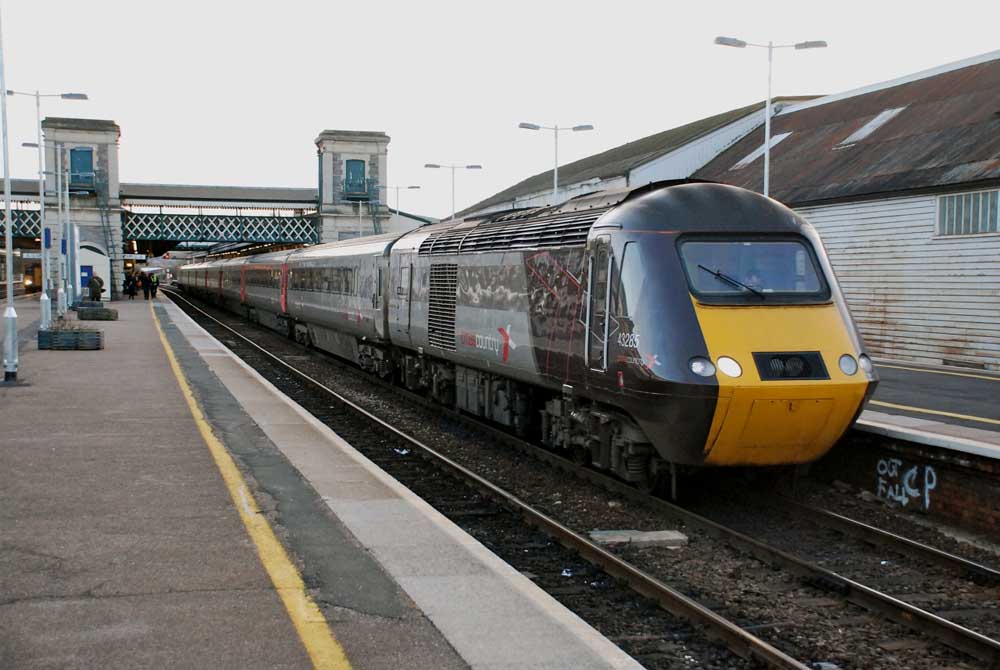
In addition a number of other operators run occasional excursions and railtours with both steam and diesel traction. With a couple of notable exceptions none of the regular passenger trains are locomotive and stock but diesel units of some description, ranging from a 2+8 HST down to a single car class 158/3. The exceptions are the Paddington – Penzance sleeper that runs each six nights a week with Class 57 locos (basically re-engined Class 47s). Due to stock shortages two diagrams have operated for the last couple of years with stock hired in from private operators with a Class 57/3 or 67 at either end, as the diagrams are too tight to allow a run-around. One set worked between Cardiff and Taunton, and the other between Cardiff and Paignton. At the time of writing (November 2010) these two diagrams have just finished.
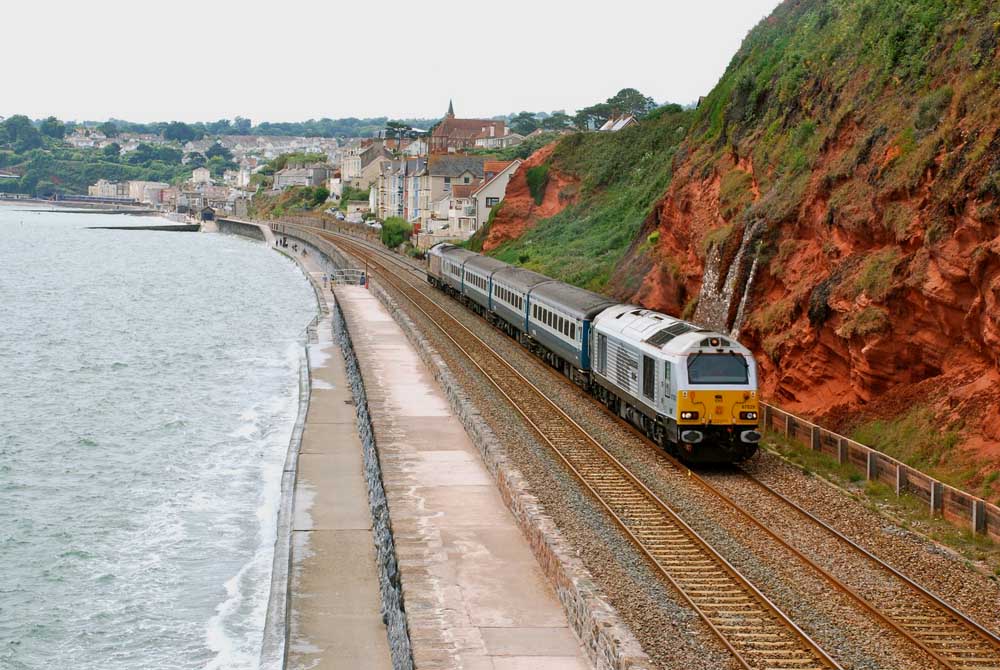
The remaining freight is mainly operated by EWS (now DBS, a division of Deutsche Bahn) and Freightliner, using Class 66 locomotives (although the odd 59/2 or 60 may appear), with occasional traffic handled by Colas Rail or Mendip Rail.
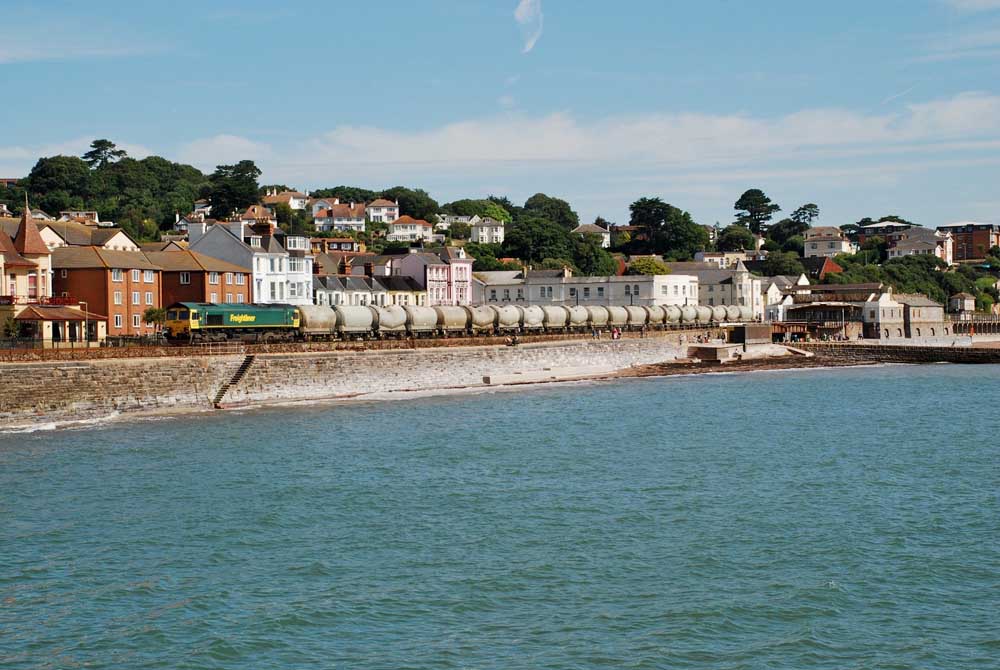
On the passenger side the pattern of traffic has changed with much less seasonal contrast. Services are more frequent than in the 1970s, especially in Devon. Exeter to Exmouth is now a half hourly interval service with alternate trains continuing to Barnstaple or Paignton. In the early 1970s most of the Exmouth trains terminated at Exeter Central. Anyone travelling further afield had to hope their arrival coincided with a Waterloo train or walk down to St Davids. Summer Saturdays are not significantly different from weekdays. The available rolling stock is used much more intensively, and there is limited capacity to provide additional trains, although Paignton and Newquay see additional through services. The holiday season is also now much longer with less rigidity on ‘Saturday to Saturday’ bookings.
Looking now in more detail at the extent of change the following are based on three recent journeys from Bristol to Exeter, Exeter to Penzance and Exeter to Barnstaple.
Bristol - Exeter
By comparison with the 1970s I find Bristol Temple Meads a soulless empty place today. It’s long platforms (it’s is probably the only station in the country to have S shaped platforms) are occupied briefly by short trains on intensive diagrams. The longest trains are 8+2 HSTs, the remainder being units ranging from one to five vehicles. The biggest loss is the mail, newspaper and parcels traffic. Vans would be stabled in the middle roads, the bays at the south end of the station and the two dedicated parcels platform opposite the entrance to Bath Road Depot. The station pilot would shunt adjustments to numerous trains at this crossroads of the West of England – North and London – South Wales axis. A small army of Post Office and railway workers would move trolleys and barrows of parcels and mail sacks, while electric tractors would hurry around with strings of crashing BRUTEs. Now all of this has gone, and apart from a brief rush when trains arrive and depart the platforms appear spacious and cold.
Bath Road Depot, for over 25 years a resting place for Class 45/46s eventually closed in 1995 and has since been completely demolished. The main depot at Bristol is now FGWs HST depot at St Phillips Marsh the site of the GWR freight engine shed. Bristol still sees a range of freight traffic from Avonmouth docks including imported coal for the remaining UK coal fired power stations. EWS has opened a small depot at Barton Hill north of the station, while Freightliner locomotives are stabled at Bristol Parkway where there is a fuelling facility. Plans to dredge the Severn Estuary and Avonmouth port area could again see Bristol being the premier port for traffic from the Atlantic. Units for local services come from either Exeter or Cardiff.

Departing westwards from Bristol, we pass under the girders of the Bath Road bridge and head towards the suburban stations at Bedminster and Parson St. Having got their trains on the move locomotive hauled trains would now be on full power as they climbed towards Flax Bourton. From a loco-spotting point of view there were two installations to watch out for. On the left hand side the former Malago Vale carriage sidings have been lifted and the ground re-developed, while on the right near Parson St was Bristol West Depot. Here a freightliner depot was built in the 1970s and subsequently closed. It has recently been re-opened as Bristol Railport with a daily train each way to or from Grain or Tilbury.
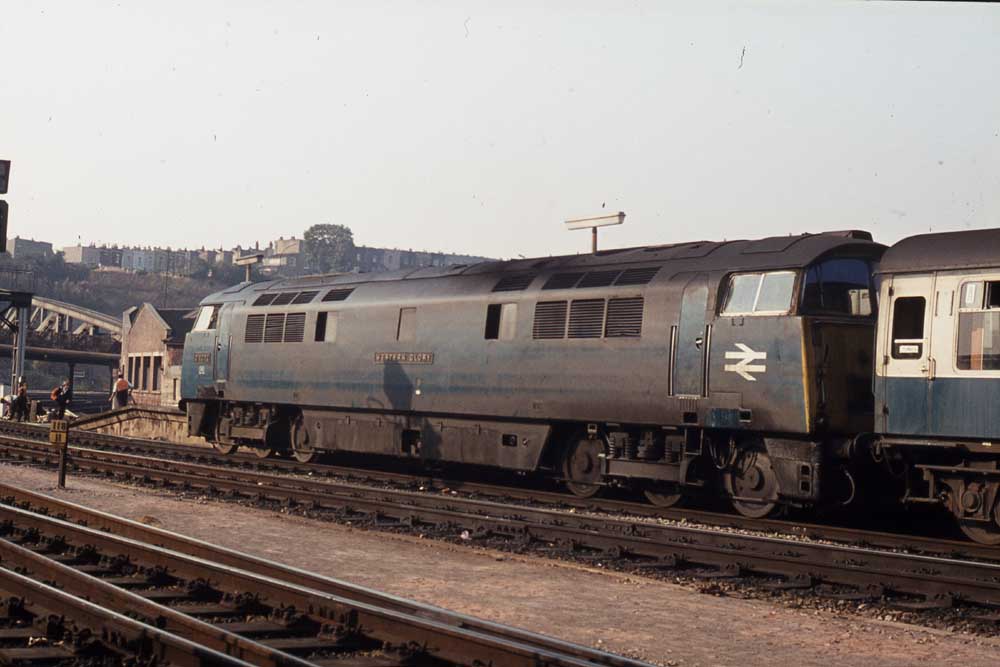
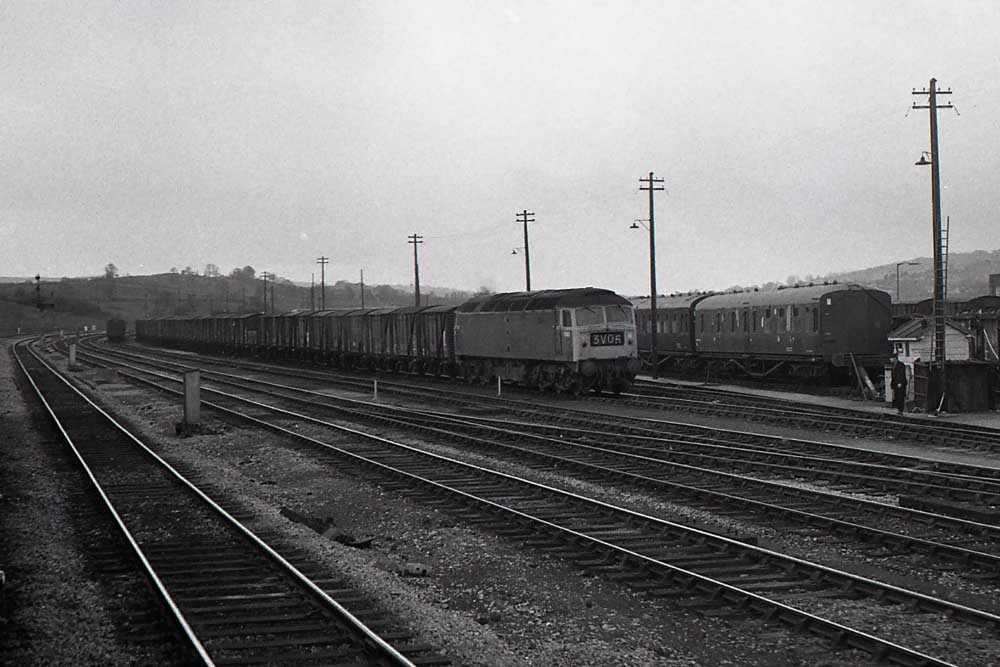
After climbing over the edge of the Mendips at Flax Bourton the line descends for six miles towards Yatton. Down this incline the Class 45/46s would build up their speed to cruise across the Somerset Levels at a steady 85/90mph. With their greater power to weight ratio today’s HSTs and Class 220/221s move effortlessly at over 100mph. Soon after roaring through Yatton the loop to the first major location at Weston Super Mare branches off at Worle Junction. In the 1970s Weston was the terminus for many of the Paddington – Bristol expresses. The locomotive could be run around and the stock serviced without causing congestion in Temple Meads. In addition the occasional inter-regional (although it added 12-15 minutes to come off the main line) and Bristol – Taunton stoppers called here. Today only a couple of Cross-Country trains call here in each direction but it is otherwise well served by the semi-fasts and stoppers from Bristol to the West.
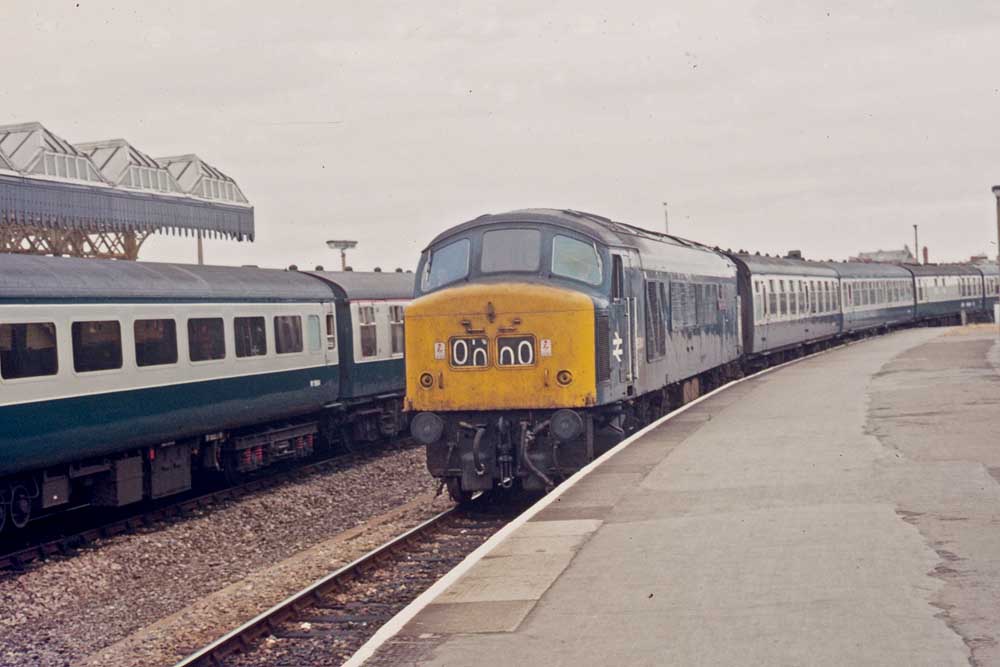
After the Weston Super Mare loop joins the main line at Uphill Junction we pass the site of the closed Bleadon & Uphill Station. As we flashed through in the 1970s we would look out for a glimpse of the 0-4-0 saddle-tank 1338 preserved on the platform, it would later find a home at Didcot. Next is the small town of Highbridge where the Somerset and Dorset line to Highbridge Wharf once crossed at right angles. Highbridge was also the Workshops for the Somerset and Dorset and even in the 1970s you could glimpse the buildings and station remains. Until about the late 1960s there was a ferry service from Highbridge to Barry Island, and we did consider using it to visit Woodhams Yard. In the end we travelled via Bristol and Severn Tunnel Junction as we would have missed the South Wales freight if the ferry had been taken.
As the train continues we suddenly notice a distinct smell and are passing the British Cellaphane factory at Bridgewater. In the 1970s there always seemed be a locomotive on a trip freight at Bridgewater. In the early days a Hymek or NBL class 22, in later years a Class 31 or 37. Today the small yard at the north end of the station still handles nuclear flasks from the atomic power station at Hinkley Point. DRS take these to Sellafield for re-processing.
Soon the line starts to climb slightly above the Athelney Marshes and we rattle through the girder bridge of Cogload flyover, where the direct line from Paddington comes in underneath from the left. In the 1970s we would now have raced down off the flyover to join the four track section to Taunton. Today the track has been rationalised and the four tracks quickly combine to two for the approach to Taunton.
The trackwork on the approach to Taunton is now much rationalised with the former goods yard closed and lifted. However, the old water tower still bears the name Taunton Freight Concentration Depot and the former National Carriers Depot stands derelict. How much longer this will last for is questionable, given the development in the immediate area. During the 1960s the island platforms at Taunton were closed with the tracks retained for through trains. These platforms have now been re-opened and provide increased operating flexibility following the track rationalisation elsewhere. At the west end of the station the small stabling point adjacent to the former steam depot is no longer used, any occasional visiting locomotives being stabled in the west end bay. Alongside the still standing rickety corrugated shed building the main line locomotives would have stabled, which typically would be between two and four main-line locomotives depending on the day of the week, and would normally include a pair of Class 31s known as the ‘Taunton Twins’. These were probably allocated for civil engineers work from Fairwater Yard, but in reality were the unofficial stand-bys for any main-line failures.
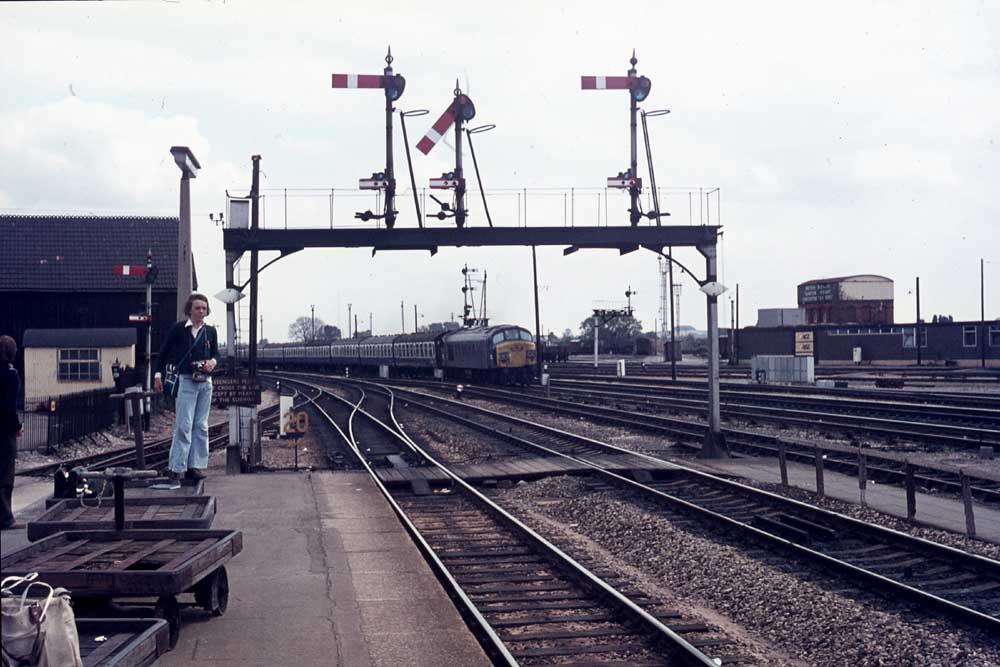
In the 1970s Taunton was still a busy centre with vans attached to the evening parcels trains. In addition to normal mail and parcels Van Heusen shirts from the adjacent factory would also be loaded. Red Star parcels traffic was also busy. A regular traffic was in day old chicks that were despatched for poultry farms in Devon and Cornwall. After hatching the day old chicks did not eat for about 36-48 hours so there was a short window of opportunity to transport them before they required feeding. We would sit on the down platform waiting for the next train next to BRUTES full of ventilated boxes full of chirping chicks. The other regular Red Star parcel traffic was boar sperm in polysterene boxes, always a topic for unsavoury jokes if there was time to kill.
Leaving Taunton we accelerate under the photographic viewpoint at Forty Steps Bridge. To our left is one of the few installations to prosper, the former Civil Engineers Yard at Fairwater, for many years the home of resident shunter PWM 654. It is now the main Railtrack civil engineering depot for the West of England, seeing daily trains of track components and the base for the heavy mechanised equipment used to replace and maintain track. On the right hand side was the Taunton Cider Company who despatched their products by rail until the end of the Speedlink era, which coincided with a fall-off in the demand for cider.
Heading west we pass Norton Fitzwarren Junction, the junction for the former branches to Barnstaple and Minehead, and where the four track section from Cogload ended. Today only the Minehead branch remains, now operating as the West Somerset Railway. The longest and one of the UKs most successful preserved railways, it is the first of the five preserved lines now operating in the West Country. Across the fields the new triangle is visible which is used both by the West Somerset Railway and Railtrack to turn locomotives and equipment.
We now begin the ascent of Wellington Bank, although with today’s modern traction the gradient is not particularly apparent. In the 1970s Class 45/46s would probably reach speeds in the high 60s, before the incline began to steepen on the approach to Wellington. After Wellington the gradient is at 1 in 80-90. By the time they reached the summit at Whiteball Tunnel speed would be in the low 50s especially with a heavy train on a summer Saturday. Today the HSTs and 220/221 units spin over the summit at between 90 and 100mph.
Once through Whiteball Tunnel we are into Devon and a twenty mile downhill run to Exeter through the Culm and Exe Valleys. However, after a couple of minutes the brakes are applied and we slow for our next stop at Tiverton Parkway, one of the West Country’s newest and most successful stations. Opened in 1986 a couple miles north of Tiverton Junction it is located adjacent to the junction of the North Devon link road with the M5. For North Devon car drivers it provides a faster option than travelling to Exeter by train from Barnstaple.
Leaving Tiverton Parkway we are soon passing the site of Tiverton Junction, once the junction for passenger and freight services to Tiverton and Hemyock. In the 1970s it saw a handful of services, including the Class 45/46 hauled 06:35 and 21:20 Bristol – Plymouth services, the 14:30 Leeds – Plymouth and 14:38 Paignton – Leeds. Until the late 1970s a Class 25 would trundle down the Hemyock branch to Uffculme most days to collect the milk tanks from the dairy. The tanks would then be left at Tiverton Junction or tripped to Exeter for attachment to one of the evening milk trains for London. At the north end of the station on the up side was a small depot for heating fuel. Most afternoons a Class 33 would arrive with a trainload of oil from Fawley Refinery near Southampton. Closed when Parkway opened now only the platform and goods loops remain.

Continuing westwards the line ascends gently as we pass through the sites of Cullumpton, Hele & Bradninch, and Silverton stations, before curving from the Culm to the Exe Valleys and passing through the remains of Stoke Canon station. Little now remains of these country stations, all closed in the 1960s. Crossing the River Exe we approach Exeter and slow for Cowley Bridge Junction where the the former L&SWR lines from Barnstaple and Meldon come in from the right.

Now to our right is Exeter Riverside Yard. In the 1970s this was the focal point for the various trip freights, North Devon and Barnstaple traffic, while most through freights would be re-formed often with engine changes taking place, especially where the locomotive requirements needed to take account of the South Devon banks. Presently there is little sign of freight activity. In recent years stone traffic from Meldon has been sporadic, with aggregates coming in from the Westbury area to the virtual quarry at the south end of the yard. Today an EWS Class 59/2 59204 in DB livery (the EWS parent company) waits to return to Westbury. Exeter crews are no longer normally involved with freight workings so there is little need for through trains to call at Riverside. In the 1980s, after the closure of Stoneycombe Quarry, there was extensive traffic from Meldon using a variety of locomotives including Class 45/46s. Much of the traffic went to the former Southern Region (a link to the days when the line was part of the Southern Region) but also Newport and Bristol for use on the Western Region.
Just before we arrive at Exeter St Davids we pass the former Exeter New Yard on the left hand side. This is now used for stabling and cleaning South West Trains Class 159 units on Exeter – Waterloo services. The approach to Exeter St Davids is something of an eyesore. The former Riverside Goods Depot is derelict having stood empty for nearly 40 years, the guttering and drain pipes collapsing with water running down the walls. Finally we arrive at Exeter St Davids. Here the former wooden goods depot stands partially demolished following a fire with the remainder looking in a very poor state. Most westbound arrivals now use platform 4, formerly the main arrival platform for Waterloo services in the opposite direction. The trackwork and signalling were extensively altered when the semaphore signals were replaced in 1985 and would have been used by some of the final Class 45 and 45/1 hauled services.
Exeter – Penzance
The journey westwards to Penzance actually starts at Digby and Sowton on the Exmouth Branch now marketed as the ‘Avocet Line’. This is close to where my mother-in-law lives, and is a recently opened station situated on the edge of a new housing development with extensive adjoining park and ride facilities. Services operate every thirty minutes with trains running to Paignton and Barnstaple alternately. This is a drastic improvement on the early 1970s when most Exmouth trains terminated at Exeter Central.
The only rather negative point is that services are mainly operated with Leyland Class 142 units. The bus type bodies are carried on a four wheel chassis rather than bogies. They first appeared in the 1980s as replacements for the first generation DMUs, but were soon banished to the North due to excessive wear on the tight curves of the Cornish branch-lines. Now they have re-appeared to meet rolling stock shortages. Their large windows and low back bench seats give a spacious feel that is reasonable for short journeys, but offer a poor standard for anything longer.
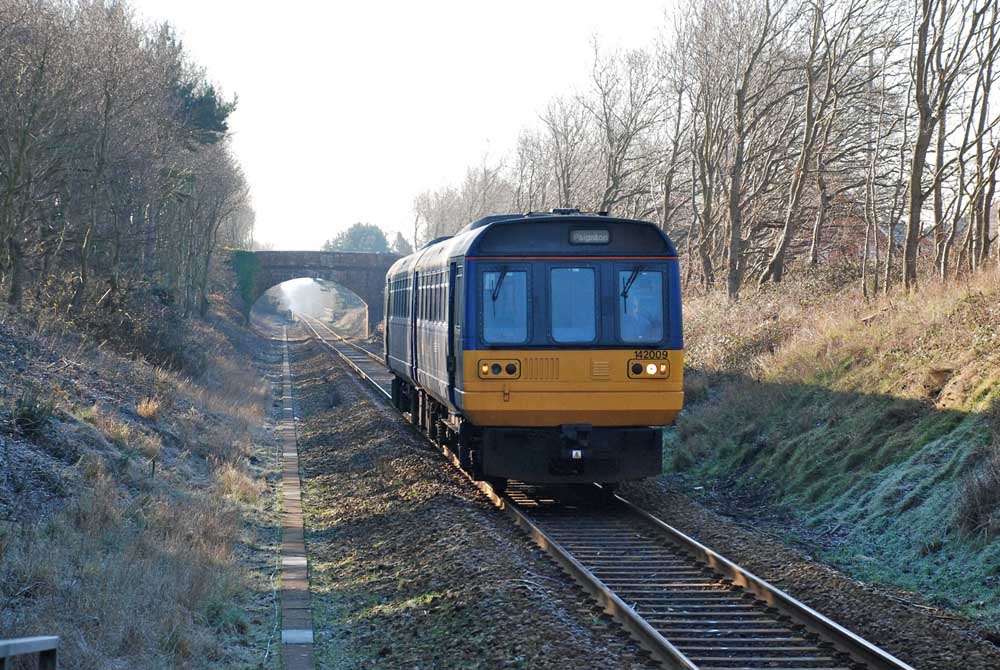
After leaving Digby and Sowton we call briefly at Posloe Bridge Halt, before joining the former LSWR main line at Exmouth Junction. On our right hand side we pass the former Exmouth Junction Coal Concentration Depot. Now un-used, the trackwork and unloading facilities are still in place, but covered in Rhododendrons and Silver Birch trees. Opened in 1967 on the site of the former Exmouth Junction goods yard it replaced the many small coal facilities that existed at virtually every station, however the decline in domestic coal consumption has rendered it obsolete. In the early 1970s a working from Manvers Main would arrive most days behind a Class 45. At Exeter St Davids an assisting locomotive from the depot, often a Class 25 would bank the train to Exeter Central.
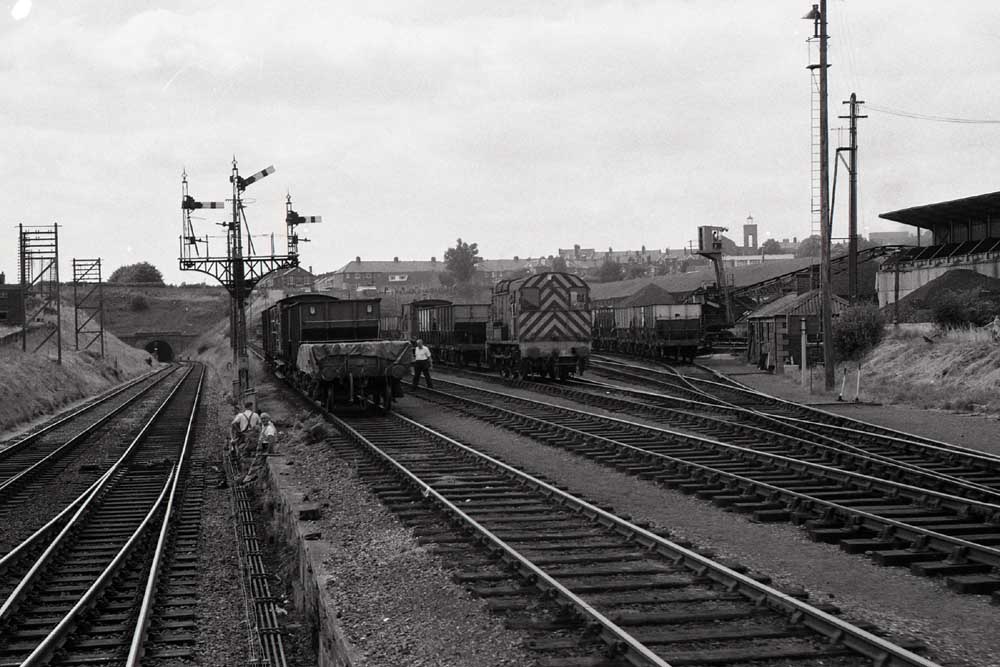
We soon enter Blackboy Tunnel and after a brief stop at St James Park Halt arrive at Exeter Central. Now devoid of much of the former trackwork and facilities its position close to Exeter city centre and frequent local services has seen passenger use return to the same level as the 1950s. This is despite it no longer offering through services to such exotic locations as Padstow, Bude, Torrington, Ilfracombe, Portsmouth and Brighton.
The majority of passengers disembark at Central, and after taking on some replacements we roll down the steep incline to Exeter St Davids, where this service will reverse and head off to Paignton. I wander over the footbridge to Platform 6 to view the former locomotive depot. Exeter is now the main depot for local passenger services west of Bristol, and has an allocation of some 30 two car and 12 single car units of Classes 142/150/153. The former goods line and St Davids Goods Depot sidings are all used for stabling stock.
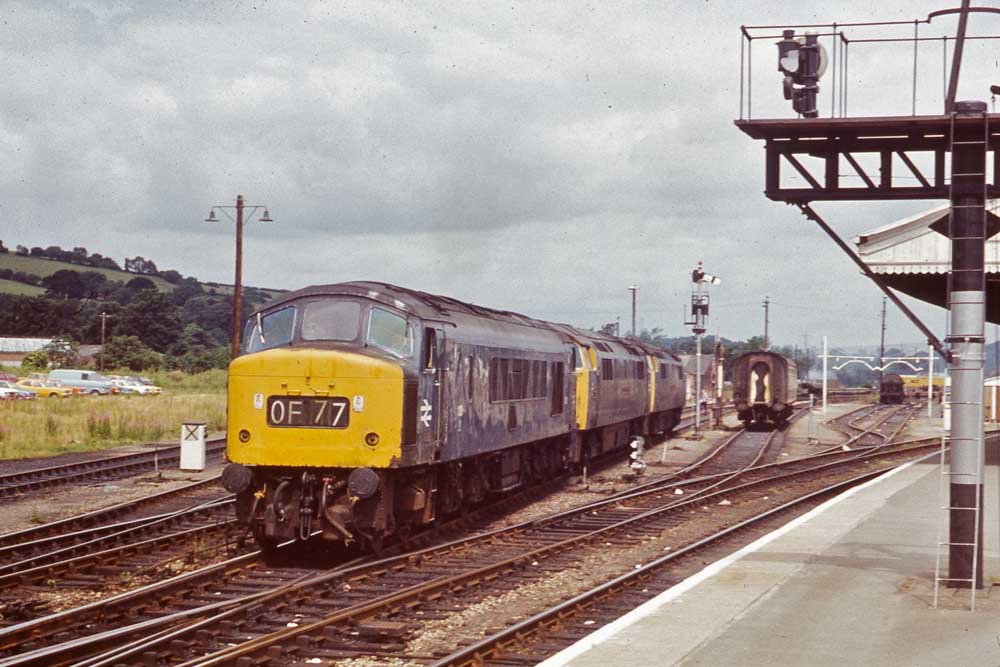
My train to Penzance is the FGW 07:30 from Paddington. This train now runs via Bristol with an HST 125. In the 1970s it ran on the direct Berks and Hants route via Westbury. We depart on time at 10:14, compared to 10:22 in the 1972 timetable. After passing through Exeter St Thomas the line to Alphington Road branches off to our right. The track is quite shiny, evidence of scrap metal traffic.
As we race across Exminster Marshes I catch a glimpse of the house where I lived from 1969 until 1979. Compared to travelling in the 1970s rail travel now appears to be much more safety conscious and risk averse. At St Davids notices warned me not to run on the platform and to exercise extreme care on wet surfaces, while loud-speaker announcements request me not to fall down the gap between the platform and carriage door. After welcoming me to the train the guard (or train manager) asks that I spend a few moments familiarising myself with the safety instructions. This is quite detailed and informs me in the event of an emergency where the first aid and emergency tools are located, how to remove the glass from the sliding doors to the vestibules, how to exit the train and when safely on the ground to watch out for a live third rail or overhead lines.
Soon another announcement is made concerning luggage. To ensure that the aisles are kept clear large items should be stowed in the racks at the end of each coach, with small and medium weight items on the racks above the seats. Please keep an eye on your luggage at all times and make sure you take it with you when leaving the train. Furthermore please watch other items of luggage and if they appear to be unattended inform a member of the train staff or British Transport Police immediately. All of this seemed a far cry from the 1970s when travel seemed much more carefree. Even more so from the 1960s when for the price of a 3d platform ticket we would manoeuvre the parcels barrows from under the canopy at St Davids out into the sunshine at the end of platform 5 which would then provide a seat with an uninterrupted view of all the running lines and engine shed.
With speed approaching 90mph we pass the site of Exminster Station. Closed in 1964 the loops and sidings remained until the semaphore signals were replaced in 1985. Speed falls off as we run beside the estuary and past Powderham Castle with its large herd of deer. The next station is Starcross where a ferry still operates in the summer to Exmouth. In GWR/WR days this was advertised as the route to Exmouth. Now there is an hourly service from Starcross via Exeter St Davids.

Soon we are approaching Dawlish Warren, the platforms are situated on loops, where stopping trains are often recessed for fast trains to overtake. We are now running beside the sea and curve around beside Langstone Rock. On this section major engineering work has recently taken place along the sea wall, with the addition of a large cill or lip to stop further erosion by the winter storms. Work is now currently under way on the red sandstone cliffs. Further along the seawall between Teignmouth and the last tunnel netting has been applied to the cliff face with a high mesh fence between the cliffs and the track to prevent loose rocks from landing on the trains or track. It looks as this is now being applied to the section from Dawlish to Langstone as well. Although understandable it is not aestheticly attractive for photographers.
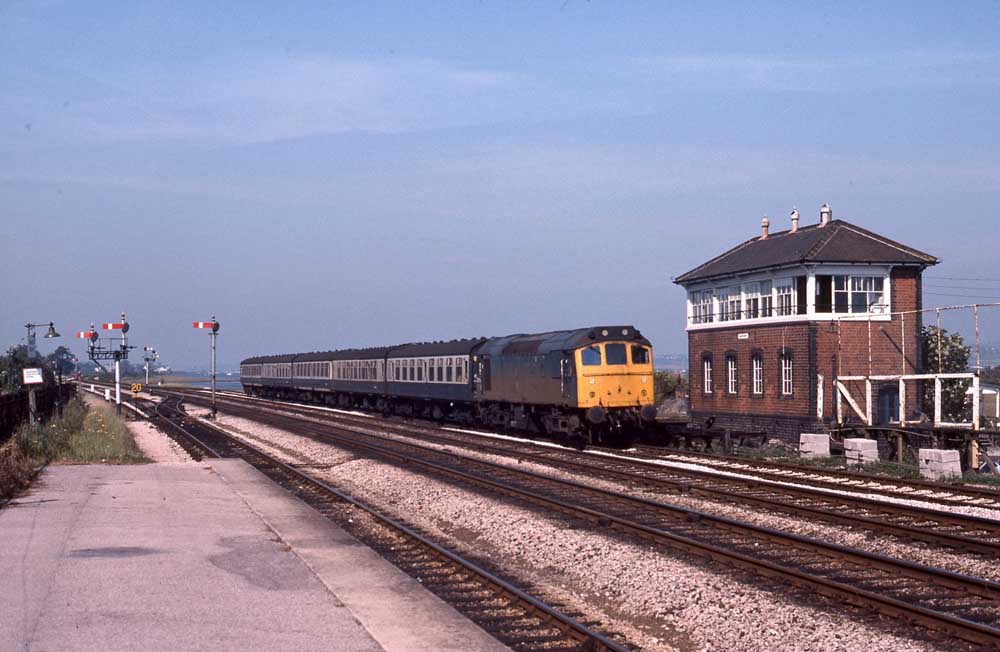
We run through the squat station at Dawlish, during the winter months it is often lashed by fierce storms. On the up platform the listed signalbox still remains, wrapped in polythene to reduce further decline. After running beside the promenade and boating cove we enter the first of the five tunnels as the railway cuts through the sandstone cliffs. After slowing through Teignmouth we head up the Teign estuary towards Newton Abbot. Soon we are passing the former Hackney Goods Yard now reduced to a run round loop and a couple of sidings and ease to a stop at Newton Abbot. On our right the line to Heathfield lies heavily rusted. Until the 1980s this saw regular ball-clay traffic and received one or two weekly block trainloads of heating oil from Waterston.
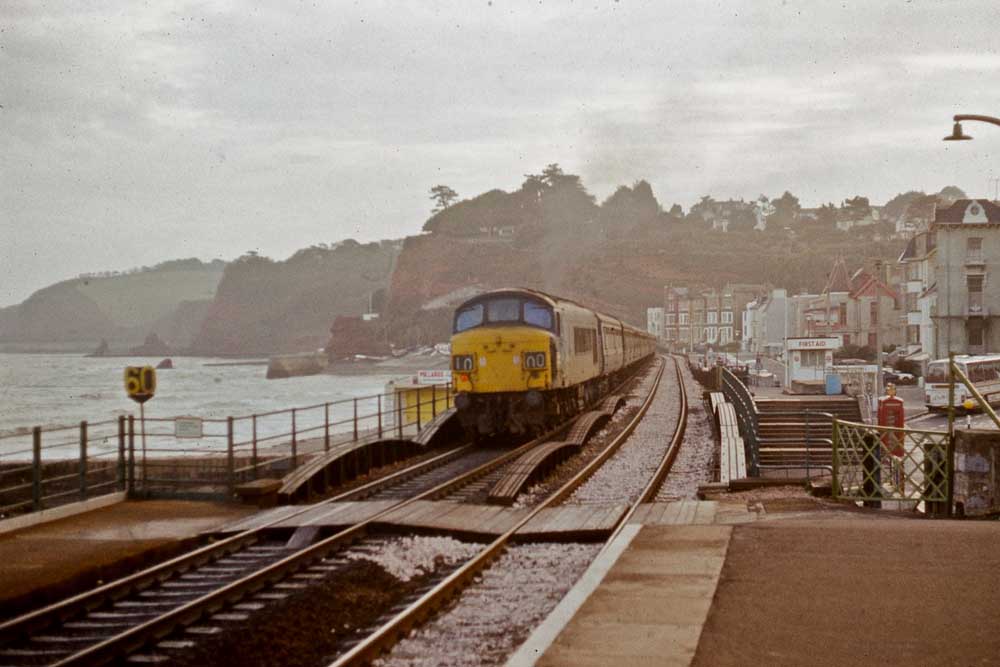

Compared to the 1970s the layout has been severely rationalised. The locomotive depot and carriage sidings to the south of the station have now all been lifted, the land being developed with small industrial units. The only building to remain is the old South Devon Railway Works. This was used in steam days to overhaul small tank engines avoiding the lengthy trip to Swindon. In the diesel era it was used for Newton Abbot's fleet of Class 42/43 Warships requiring heavy maintenance (so would have seen plenty of Class 43s!). Access was via a traverser at the east end. On the south side of the station the down through line has been removed, while on the north side the up through line and adjoining up Plymouth platform line have been removed, the space now filled in as a car park. This just leaves three platforms now signalled for bi-directional working. West of the station the three tracks increase to four with the physical junction of the Plymouth and Paignton lines. The former Aller Junction is now just Aller Divergence.
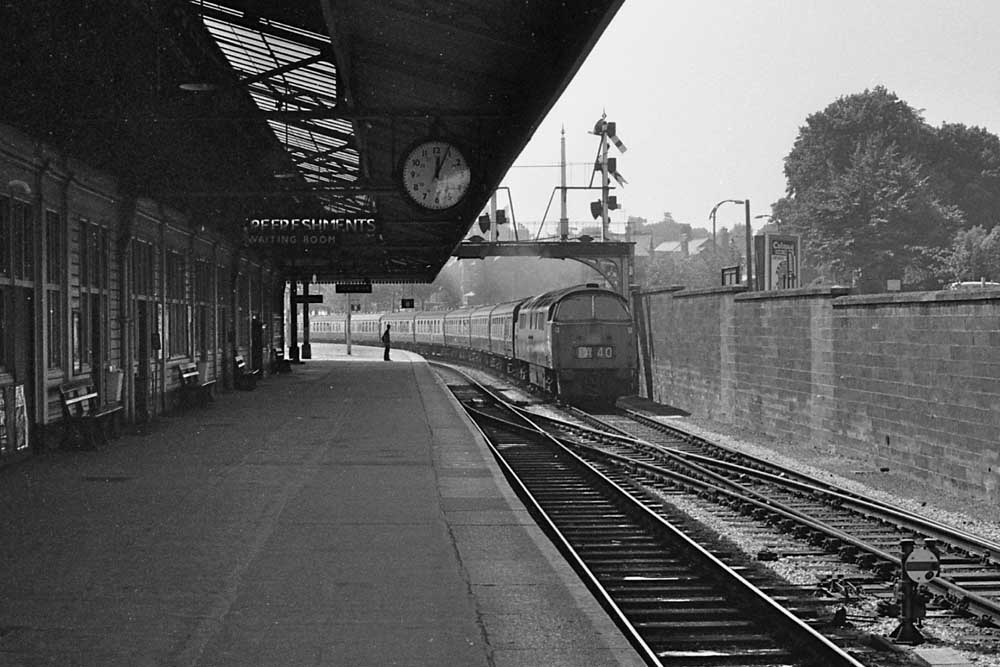
Even after Newton Abbot lost its allocation of Class 42 Warships in about 1971 it was still an important stabling point. The five sets used on Exeter – Waterloo services were allocated here with two or three sets returning every night for servicing. The stock for the 07:55, 09:55 and 11:55 Paignton to Paddington services were based here along with one of the sets for the 10:50 Paignton – Leeds ‘The Devonian’. There would also be a few rakes of Mk1 sets used for summer Saturday extras and reliefs, and the four coach sets used on the local services.
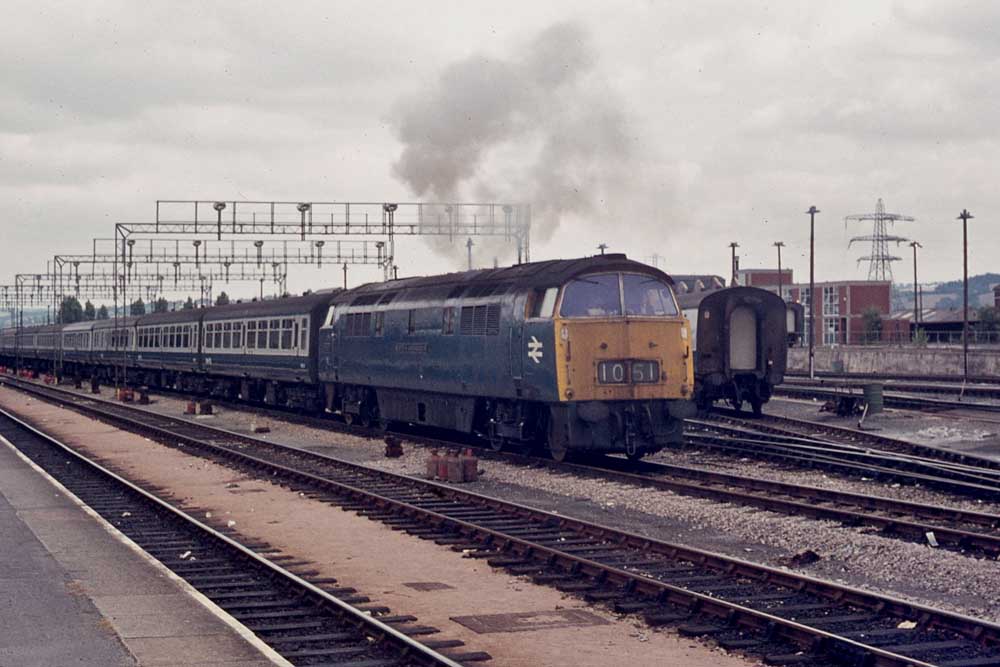
During the 1970s the ‘Devonian’ was worked virtually exclusively by Holbeck based Class 45s. In pre TOPS numbering days they were always low numbers and a friend of mine would add the numbers of each days locomotives on the north and southbound workings together, hoping for the cherished 23. After arriving at Paignton, the incoming locomotive would work the stock back to Newton Abbot for servicing. It then worked an evening freight from Hackney to Exeter Riverside Yard and back. Next morning, after servicing overnight, the locomotive would do two or three fill-in trips from Newton Abbot to Paignton with three coaches off the Devonian set. At about 10:00 it would put the set back together and return to Paignton for the northbound working.
Leaving Newton Abbot we run on the four track section to Aller Divergence where we swing off to the right. Still visible alongside the line are the remains of the former loop. Until the end of the 1960s a Class 43 NBL Warship would wait ‘smouldering’ away ready to bank the next westbound freight. Compared to the 1970s the HST romps up the 1 in 37 of Dainton Bank. As we curve through the woods we pass Stoneycombe Quarry the trackbed of the two quarry lines clearly visible beside us. On our right the former Stoneycombe Signal box still exists, now boarded up. Bursting out of the woods we curve up the final yards to Dainton Tunnel.
Emerging from the west entrance to the tunnel we pass the site of Dainton signal box and its adjacent sidings, although I was never sure what they were used for. With the brakes constraining our speed we snake down through the curves of the west side of Dainton Bank. As we approach Totnes the preserved South Devon Railway (formerly the Dart Valley) swings in on the right with their southern terminus. Called Broadhempston it is linked by a footpath to Totnes Station. The layout at Totnes is largely unchanged since the 1970s, but the sidings where the milk tanks were stabled and motorail wagons unloaded have been lifted allowing the up platform to be extended. Sadly the former dairy stands derelict beside the station. The former signalbox has survived and re-opened as a café.
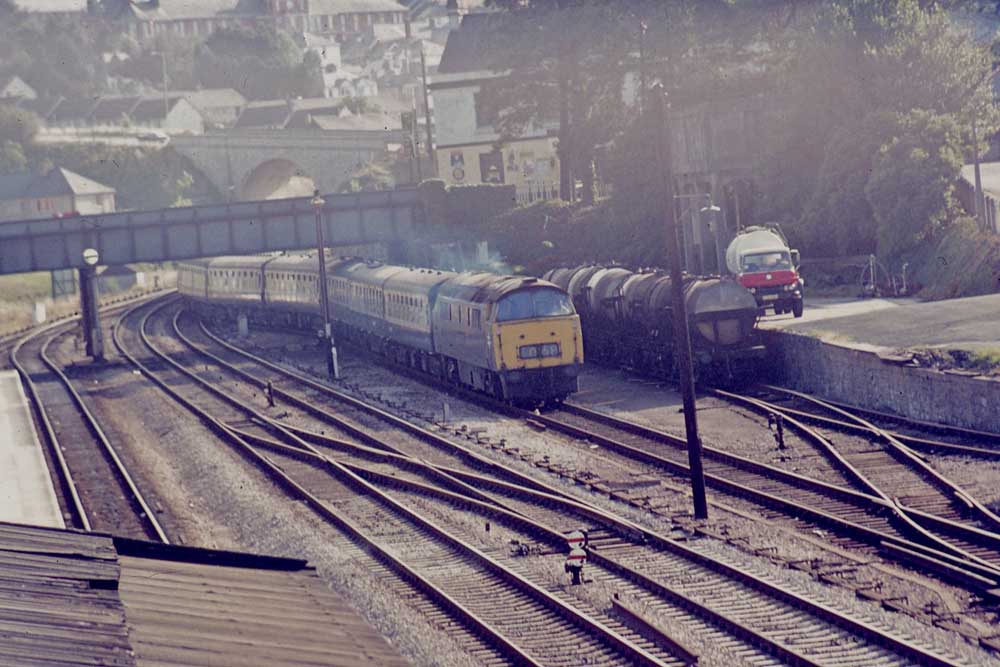
Leaving Totnes we hammer up Rattery Bank. As we climb up past the site of Tigley Signalbox with its little church the gradient eases from 1 in 46 to 1 in 90. Soon we are passing through the twin bores of Marley Tunnel and emerge with the hills of Dartmoor on the north side of the line. To the south the rolling hills of the South Hams seem to go on forever. Still climbing gently we pass through the remains of Brent, once the junction for the branch to Kingsbridge before easing over the summit of the line at Wrangaton. On the gentle descent towards Plymouth we approach Ivybridge with clear evidence of residential development over the last thirty years. The original station was closed in 1965, but in 1994 a new station slightly to the east of the former station was opened to serve the large number of commuters travelling to Plymouth.
Continuing downhill towards Plymouth speed is kept in check as we approach Cornwood and sweep over the impressive Blatchford and Slade Viaducts. Soon we pass a loop on the up line and have reached Hemerdon where the 1 in 42 descent to Plympton begins. We accelerate rapidly and are soon speeding through the outskirts of Plymouth. On our right is Tavistock Junction Yard. In the 1970s mosts freights would call here, now it only contains some empty fuel tanks from Laira and and a Railtrack maintenance train.
As we run down beside the Plym estuary we look out to the left to catch a view of Laira depot. Now a base for FGW HSTs only a few spare coaches and a power car are visible. The former steam shed or ‘dump’ only contains a couple of HST barrier vehicles. Superficially the depot looks much the same as in the 1970s. Closer examination reveals that the trackwork and layout in the running shed have been adapted to cater for 2+8 HSTs rather than individual locomotives. Rather than a single fuel point that topped up incoming locomotives with diesel fuel, coolant, hydraulic fluid and sand, HSTs now need a layout with a fuel point at either end.
Speed falls off as we climb up towards Mutley Tunnel, the pair of tracks coming in on our left are the former lines to the Southern station at Plymouth Friary, now used as part of the Laira Triangle. Emerging from the tunnel we continue under a multi-storey car park, before entering Plymouth Station. As with Bristol, Plymouth now seems very empty through the loss of parcels and mail along with the attendant BRUTES trolleys and barrows. In the 1970s although there were fewer trains at Plymouth than at Exeter every train was an event. They would either arrive or depart from Laira as ECS with the engine running around, or if passing through would change engines and attach or detach a restaurant car portion.
As a general rule inter-regionals would change locomotives in both directions. Westbound Paddington trains would normally just detach the restaurant car portion with the locomotive working through to Penzance. On London and northbound inter-regional services a fresh engine would arrive from Laira, couple up to the restaurant car portion and move up into the head-shunt at the east end of the station. With the arrival of the train from Penzance the locomotive would be uncoupled and head off for Laira, and the fresh engine and restaurant car portion back down and couple-up. The station shunter would be busy moving parcels vans and portions around the station. The sidings on either side of the station would be full of newspaper and parcels vans, and restaurant car portions. Now they just stand empty.
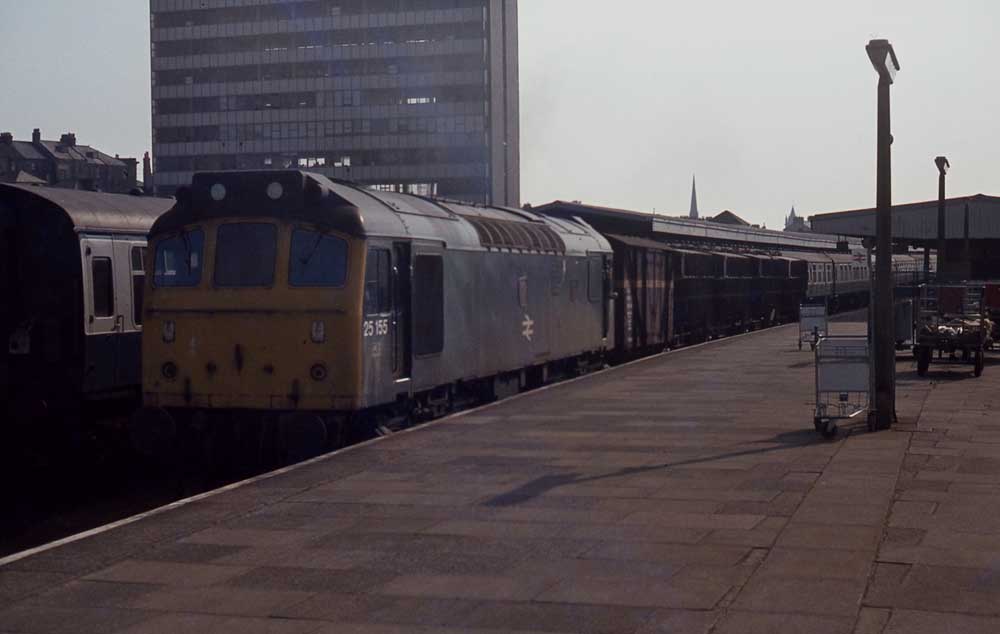
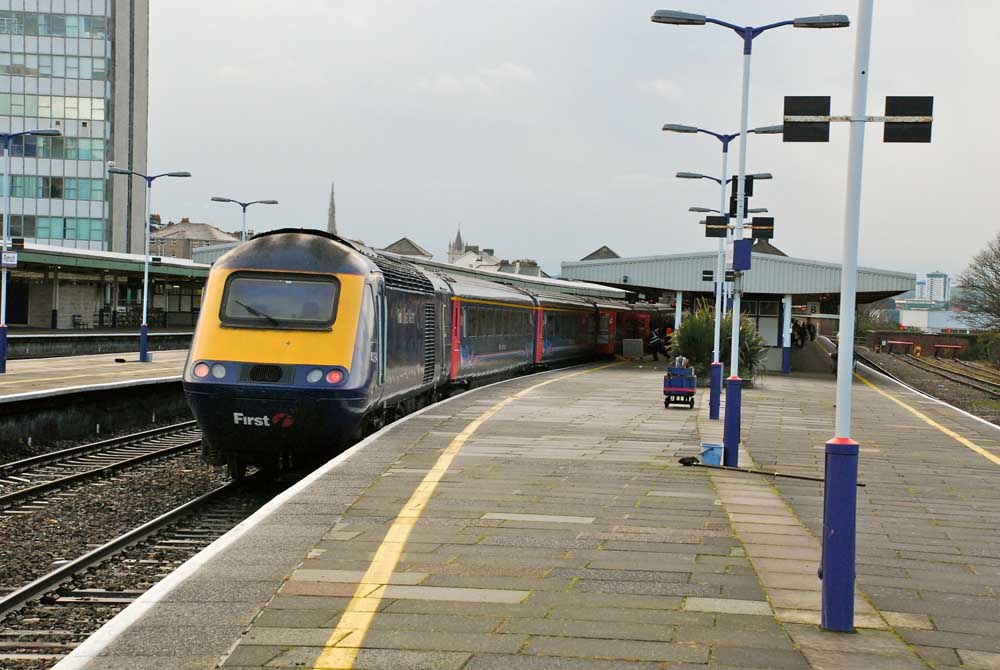
After just four minutes compared to the ten minutes allowed in the 1970s we are moving on. To our left the track-bed and cutting of the line to Millbay docks and carriage sidings are still visible, although not used for over 40 years. Leaving Plymouth we cruise through the various local stations of Devonport, catching glimpses of the naval dockyards on our left. At St Budeaux is the junction to the former Southern line to Waterloo via Okehampton, now just the branch to Gunnislake. The line now becomes single track and swings sharply to the left, and we are slowly threading through the Royal Albert Bridge at Saltash high above the Tamar Estuary. Passing through Saltash Station we regain double track and speed increases as we start climbing towards Liskeard, passing through the small stations at St Germans and Menhenniot.
Approaching Liskeard I catch a flash of red outside the carriage window. It looks vaguely familiar and after a few seconds I realise that we are now being controlled by semaphore signals. It suddenly dawns on me that this is the first time that I have travelled by rail into Cornwall since the 25080 hauled ‘Wadebridge Wanderer’ in September 1978.
Crossing over the viaduct as we run into Liskeard, the Looe branch platform approaches at right angles to the main line. Here the station nameplates have been restored in GWR brown and cream. Elsewhere along the line the application of FGW's purple colour scheme does not really suit the remaining former Cornwall Railway buildings. Leaving Liskeard we pass under the droopy GWR style lower quadrant signal and head towards Bodmin Road. Passing over Moorswater Viaduct below us is the cement depot that still sees regular deliveries via the Looe Branch. In the 1970s there was also a clay dry here that despatched china clay behind Class 25s up the steeply graded line to Liskeard.
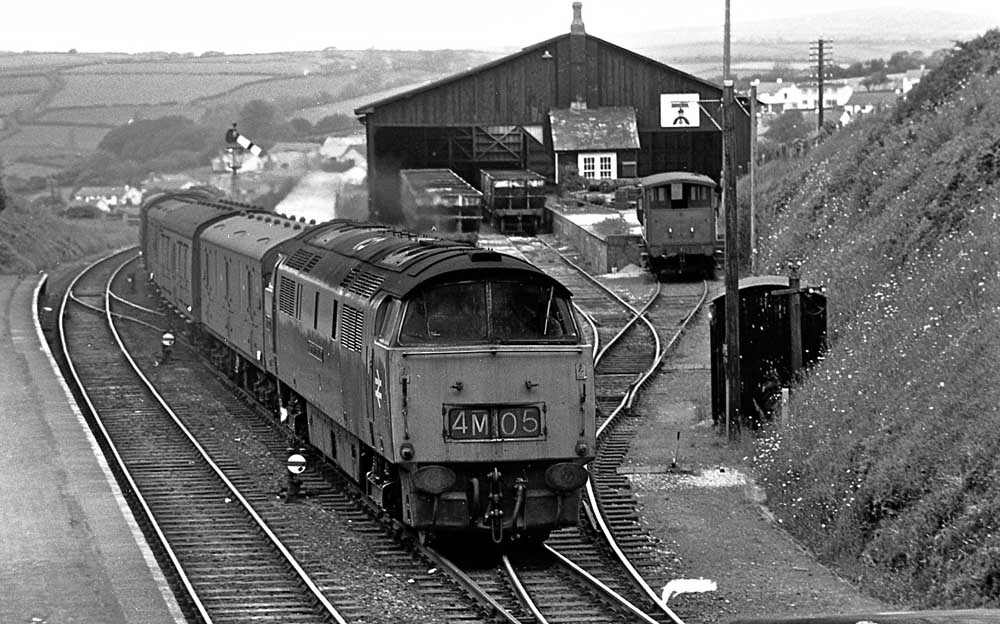

We climb sharply to Doublebois before descending into the heavily wooded Glyn Valley. The line is now running ‘against the grain’ of the landscape and we start to cross a series of viaducts reverting to single line over East Pinnock and Largin Viaducts. After regaining double track and crossing West Largin, Derrycombe, Clinnick and Penadlake viaducts we approach Bodmin Road. As we round the curve a pall of smoke appears above the station. The smoke belongs to ex GWR pannier tank 4666 which is standing with three Mk1s on the branch platform, now used by the Bodmin & Wenford Railway. In fact the locomotive is 4612 but is carrying 4666 plates that was allocated to Wadebridge in the early 1960s. During the 1970s freight still operated to Wadebridge, mainly fertiliser from Avonmouth with Class 25s, and china clay from Wenford Bridge with Class 08s. Traffic to Wadebridge finished in 1978, and Wenford Bridge in 1982.
Departing from Bodmin Road we pass through Brownqueen Tunnel and head into Lostwithiel. The trackwork at Lostwithiel looks much as it did in the 1970s where china clay traffic runs around before proceeding down to Carne Point. The milk processing plant is now closed and has not seen any rail traffic for 30 years. Although there are no freight trains as we pass through, the polished track in the loops are evidence of recent traffic. Under clear semaphore signals we climb out of Lostwithiel towards Treverrin Tunnel, before descending to our next stop at Par. Again there is no visible freight traffic although the loops are well polished.
At Par we stop opposite a semaphore signal gantry. Close examination reveals new lightweight ladders and balconies that give the gantries an almost timeless look – perhaps they will be restoring them elsewhere. Although the yard and depot at St Blazey are just a few yards away they remain well concealed by trees. Par is also the junction for the Newquay branch and on Fridays and summer Saturdays would have seen Class 46s climbing to Luxulyan, especially in the late 1970s after the Westerns had gone.
From Par we climb up to St Austell, one of the few stations where the old buildings are in a poor state and closed up. The former motorail bays are now filled in and totally devoted to cars, leaving just a couple of small sidings for engineers trains. In the 1970s the Kensington motorail would arrive early in the afternoon, the locomotive quickly departing to re-fuel at St Blazey while an 08 shunted the stock. The train would then be re-formed departing for Kensington at 16:00. This was a regular turn for a Taunton crew. Departing from Taunton at about 11:00 they would arrive back at about 18:45. With a round trip of 250 miles they would be entitled to mileage money as the journey was over 175 miles. (I think it was an hours pay for every 15 miles).
Leaving St Austell we now climb up to Burngullow Junction where the large clay dries at Blackpool appear to see little use. The sidings are full of china clay slurry tanks. The branch to Parkandillack and Drinnick Mill veers off to the right and we carry on along double track to Truro. In the early 1980s the 7.5mile section from Burngullow to Probus was singled, a favourite past-time of the old Western Region. The reduction in flexibility was a continual cause of delay and in 2004 double track was re-instated at a cost of £14.3 million. The savings achieved must be miniscule when compared with the money wasted in initially singling and then re-instating the double track.
Continuing through Polperro and Buckshead tunnels we descend towards Truro crossing the viaducts that span the city. Just before pulling into the station we pass Truro signal box that controls the section of line operated by MAS signals whick links up with the manual boxes at Par to the east and Roskear, near Camborne to the west. At Truro station the former goods lines on the north side of the station have all been removed leaving just a couple of sidings for occasional engineers traffic. On the site of the former steam shed stand a number of small warehouses including the former UKF depot that received block loads of fertiliser from Ince until the 1990s. A Class 150 two-car unit stands in the Falmouth bay platform.
Truro was one of the courts I would occasionally visit. The offices were located in a large Georgian house with the attic used for storage. I asked whether I could pop up in my lunch hour to take some photographs of trains crossing the viaduct, and was told just to nip up the stairs whenever a train was due. Unfortunately it was a dull November day and the results a little disappointing.
Leaving Truro we pass through a short tunnel before passing Penwithers Junction where the Falmouth branch leaves the main line. We now climb nearly four miles at 1 in 80 before we brake for the curve at Chacewater where the cement terminal was rail-served until the 1980s. A few minutes later the site of Drump Lane Yard passes on our left. Latterly used as a run-round for the Chacewater cement traffic in the early 1970s it was a busy goods depot with through trains from Exeter Riverside Yard. The next stop is Redruth. It is interesting to note here how much the platform furniture has changed. Gone are the barrows, trolleys and BRUTES to be replaced by information boards, cycle racks and white circular help points. Press a button and you can bend down and speak to someone through a microphone to find out how your train is running. The only thing that has survived are the original seats, their GWR emblems picked out in the paintwork. It all goes to prove that although many things in life change, the need to sit down while waiting for a train is timeless.
Leaving Redruth we head towards Camborne passing through the remains of Carn Brea station. This area shows signs of economic struggle being away from the main tourist attractions on the coast. As we approach Camborne we pass the signal-box at Roskear Junction that controlled the short freight branch to North Roskear until it closed in 1983. Leaving Camborne we descend downhill passing the site of Gwinear Road, junction of the Helston branch before crossing Angarrack Viaduct and passing through Hayle. Here was a little network of sidings extending to the wharves. Coal was carried to the local power station until it closed at the end of 1973. After this traffic fell off with eventual closure in 1982 by which time Class 37s had taken over from the 25s. Closure was vicious with the sidings being lifted and the signal-box and station buildings all demolished.
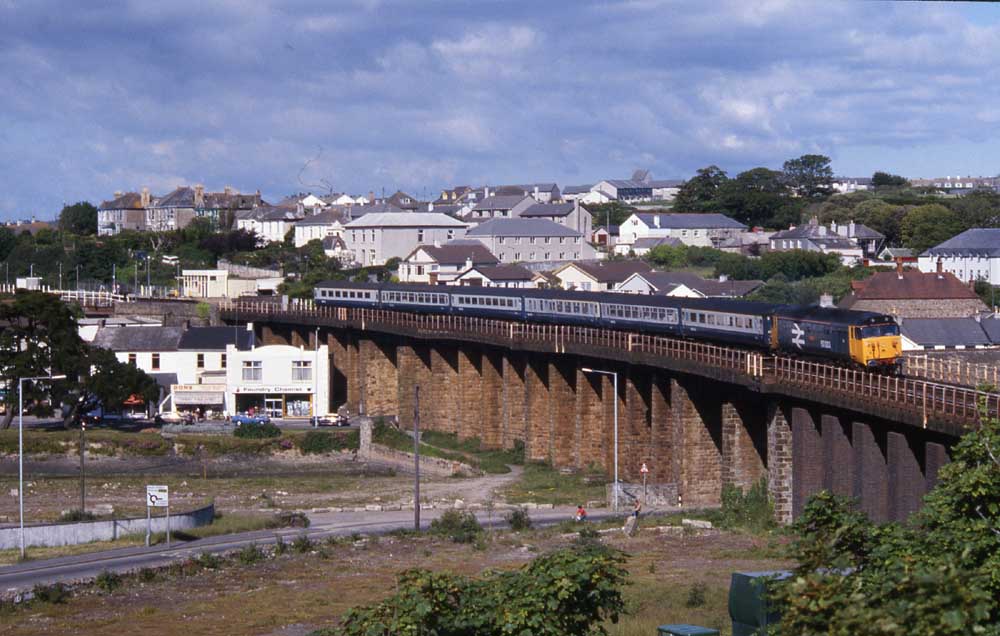
The line has now descended from Camborne almost to sea level as we approach St Erth, and on the right hand side we run beside a wide inlet with views of the large sand dunes at Hayle Towans and what estate agents would call ‘far reaching views of the North Atlantic’. The line now runs up a short incline into St Erth station with the branch line to St Ives on the right hand side. Little now remains to remind us of the milk traffic that departed from here in the 1970s.
Departing from St Erth the train passes the final semaphore signals and heads towards Penzance. Having seen the sea on the North Cornwall coast at Hayle, the South Cornwall coast comes into view as we curve around at Marazion. At the site of the former station the ancient Pullman camping cars have been moved elsewhere and replaced by brick built chalets. On the right is the site of the former Long Rock depot, now re-developed with a pirate ship! The depot was closed and demolished in 1980 when the HST depot was built at Ponsandane.
Until closure, Long Rock was used for fuelling and stabling of locomotives arriving at Penzance. Locomotive allocations were the responsibility of the inspector located at the station. To ensure that drivers knew which locomotive to take for the early morning departures they would be stabled at Long Rock with the following days working chalked on the cab side. Later in the day they would appear at Exeter with 5:05 and 6:35 still chalked on the side.
As I pass the HST depot at Ponsandane we are now running on single track, double track having been sacrificed in 1980 to provide space for the HST depot and adjoining sidings to be built. Deep inside I can just make out the Class 57 and stock for the overnight sleeper, now the only locomotive hauled train between Paddington and the West. The only other stock at the depot is the Class 08 shunter that will drag the sleeper into the station later in the day.

Finally we arrive at Penzance Station. Surprisingly the layout is completely unchanged since the 1970s, except there is no other rolling stock. Gone is the TPO stock or the vans that would be attached to afternoon and evening trains. For a number of years in the early 1980s I had taken my young family to Marazion every year and Penzance Station had been a regular visiting place, especially at the weekends when there was still plenty of locomotive hauled services, or in the evenings when the children could post postcards to their grand-parents in the side of the TPO.
In the 1970s we would often arrive off one of the overnight trains and someone would be delegated to visit the inspectors office to obtain the booked locomotives for the day. Sometimes he would not be too co-operative so an ability to read the numbers upside down on his clipboard was a great benefit. Afterwards we would have breakfast in the bus station café or one of the nearby hotels and plan our moves for the day.
Outside of the station as I look up Market Jew Street little initially appears to have changed, but on closer inspection many of the shops have changed from serving the local community to selling surf boards and other tourist items. My plan now is to walk around past the bus station and get onto the sea wall, as I had done in the 1980s to photograph the locomotive-hauled departures. The bus station is still in the same position but the motley selection of buildings that included the café have gone. However a new café has been opened in a portacabin nearby. The menu looks familiar, but the need to control my cholesterol persuades me not to take this particular journey down memory lane.
Walking around the side of the bus station towards the sea wall I find that a footpath has conveniently been laid between the railway and the sea wall. A sign informs me that I am in an alcohol controlled area and if I persist in drinking when told to stop will be liable to a £500 fine: Clearly a sign of the times. I walk along towards where I can photograph the HST in the same position as the 45/1s in the 1980s, but find I still need to clamber up the wall to gain a view above the fence, not something I practice regularly these days!

Returning towards the station I pop into the pub across the road for a drink. In the 1970s this was a typical ‘local’ now in October it is fairly empty, but clearly organised to accommodate the maximum number of binge drinkers. Outside is a line by the door across which I must not take glasses of alcoholic drink.
I board the same HST as I had arrived on, as arrival time passes an announcement is made, informing passengers that the rear power-car will not start, but fitters are on their way from Ponsandane. They shortly arrive and a couple of minutes later, the rear engine bursts into life. Another announcement is made informing us that safety checks are now being made and we will be departing shortly. Eighteen minutes late we depart from the station.
The return is similar to the outward journey. Between Par and Lostwithiel I look out for china clay traffic but there is nothing around. In some ways that was similar to the 1970s when it seemed to be either all or nothing, perhaps it depends on the tide for loading the ships at Carne Point. Running into Bodmin Road 4666 is there to greet us. As we depart the Pannier tank moves off in the same direction running around the stock. For a few yards it runs beside our carriage, for a few moments capturing the attention of everyone.
As we approach the single line section at Largin we are brought to a halt. From the opposite direction a railhead cleaning train passes with a Class 66 at either end. Finally I arrive back at Exeter St Davids where I catch another Exmouth bound 142 unit to Digby & Sowton where my wife is waiting to collect me.
Exeter – Barnstaple & Torrington
I had always been fond of the former Southern lines around Exeter. As a child in the 1950s the Southern Region was probably Exeter’s largest employer. With a population of 50,000 over 1,000 people worked for the Southern Region, with 200 guards based at Exeter Central and a similar number of sets of men at Exmouth Junction. My aunt’s father in law was a driver in the top-link at Exmouth Junction and several of our neighbours worked on the Southern. The lines were transferred to the Western Region in 1963 who devoted the next few years to closing or singling them. Whereas the former GWR stations were generally small low buildings with large awnings the LSWR stations included all facilities including the station-masters accommodation in a single building. As a result they looked almost dis-proportionately large for the communities they served. By the time I started to travel on these lines in the late 1960s they had a forlorn dignity with their crumbling concrete signs and flaking green paint.
I had last travelled to Barnstaple on May 27th 1978. Out with 31258/31311 on the 07:17 Exeter, returning almost immediately behind 33011 on the 08:25 to Waterloo (OK if you didn’t mind the 40 minute layover at Exeter). Today, 32 years later it is now branded as The Tarka Line. My journey in November 2010 starts at Digby & Sowton on the Exmouth branch with another £10 Devon Ranger (Thankfully I’m the lone ranger allowing my wife to have a days shopping with her mother). The 08:53 Exmouth – Barnstaple arrives headed by the normal Class 142 with a single car Class 153/3 at the rear. Given the length of the journey I opt for the relative comfort of the Class 153 and join the busy train.
We call briefly at Polsloe Bridge and St James Park Halts before arriving at Exeter Central, where the remaining track-work is covered in weeds. Here the majority of passengers disembark, taking advantage of the easy access to the city centre. With a brief burst of the unit engines we reach the top of the steep incline and then descend to Exeter St Davids, the brakes keeping our speed in check. We pause at St Davids for a few minutes while a crew change takes place, and then head for North Devon. Soon we are passing Exeter Riverside Yard, completely empty except for two wagons and a stabled track maintenance train. After days of heavy rain the virtual quarry at the south end of the yard looks distinctly waterlogged.
Approaching Cowley Bridge Junction we brake for the junction and then cross the two bridges carrying the line over the River Exe. We now continue on single track towards Crediton, double track having been removed in the late 1970s. After Newton St Cyres, the Creedy Valley opens out. Looking out of the window the fields that normally look flat now reveal their real profile. After days of heavy rain the ground is saturated, the sheep holding the higher ground amongst the small lakes and water filled trenches. Further along a field where the maize crop has been harvested but not yet ploughed is full of pheasants paddling around amongst the stubble seeking out the loose grains that have fallen from the cobs.
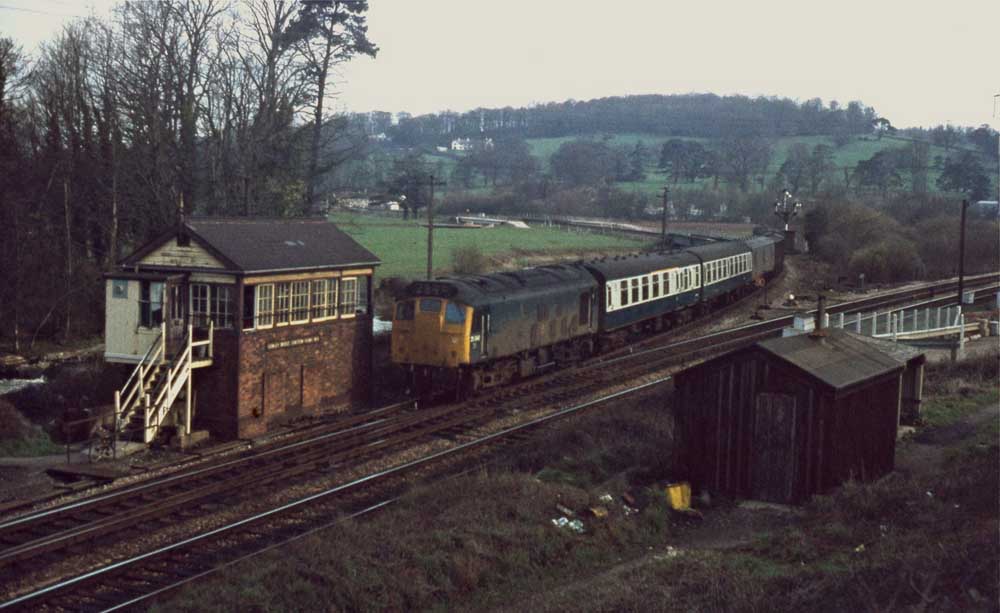
Soon we arrive in Crediton where the 08:43 from Barnstaple to Exmouth crosses on the adjacent platform. The station buildings have survived and look to be in better condition than in the 1970s, and now house a tearoom and small museum.
Originally the Southern main line to Plymouth and most of the line to Ilfracombe was double track.The two lines separated at Coleford Junction just north of Yeoford. Following the withdrawal of passenger services to Okehampton in 1972 both lines were singled with the physical junction moving back from Coleford Junction to Crediton. Okehampton trains (for Meldon Quarry) used the former westbound line, with Barnstaple trains using the former up line. Today Crediton Signal Box controls the whole of the line using the No Signalman Token Remote (NSTR) system.
Picking up the token from the signalman we ease over the road crossing and swing over onto the Barnstaple track. We now head off into the wet Mid-Devon countryside with swollen streams and muddy fields. After four miles we arrive at Yeoford calling at the former up platform. Most of the buildings were on the former down side and have been demolished. The line to Okehampton now only sees occasional stone traffic to Meldon Quarry. The section from Meldon to Sampford Courtney (on the Okehampton line) is operated by the Dartmoor Railway using heritage diesels, although a steam locomotive was borrowed for the 2010 summer season. On summer Sundays FGW operate trains from Exeter to Okehampton sponsored by Devon County Council. The Dartmoor Railway is seeking to extend their trains to Yeoford and connect with the Barnstaple line and national network. There are even rumours about them introducing an Okehampton to Exeter service top ‘n’ tailed by Class 31s!
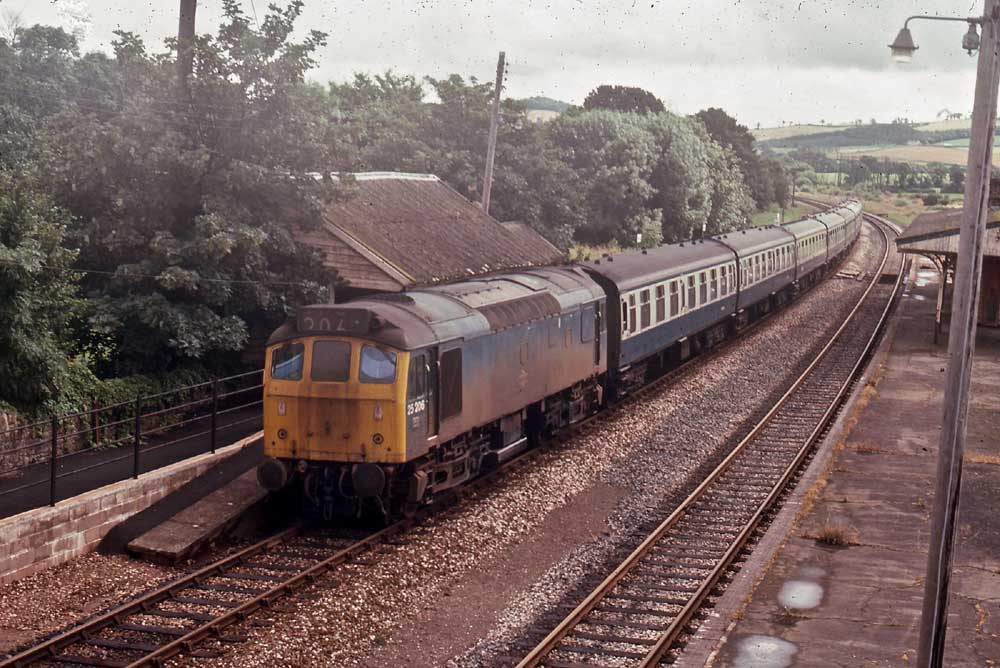
Soon after leaving Yeoford we reach Coleford Junction where the Okehampton line diverges for the high moors while we climb towards the summit of the line at Copplestone. Here the line moves out of the Yeo Valley and into the Taw Valley for the run down to Barnstaple. Copplestone was originally the start of the single line section to Umberleigh, although now it is singled all of the way, except for the passing loop at Eggesford. At Copplestone there is evidence of recent residential developments close to the station.
After leaving Copplestone we ease through Morchard Road, like Yeoford and Copplestone this is also a request stop, but has no passengers today. A couple of miles further on we approach Lapford, but this is no longer a scheduled stop. Lapford was formerly a passing loop with staggered platforms and freight facilities. Until 1980 it despatched milk from the Ambrosia Dairy and received block loads of fertiliser until the early 1990s, after Barnstaple had lost its freight facilities. Fertiliser was delivered to Lapford in UKF wagons detached from the weekly Ince – Truro service. Unfortunately it was tripped out by a Class 47 at about 04:00 from Exeter Riverside so I never managed to photograph it. Now the track has all been lifted with nothing remaining of the dairy or fertiliser depot, the whole area having been developed into self-storage units.
Next the train enters a steeply wooded valley and slows for Eggesford. We stop briefly at the road crossing for the driver to pull the cord that operates the crossing gates before entering the station. Here the driver exchanges the token and the 09:43 Barnstaple – Exmouth arrives on the adjoining platform. Formed only of a single Class 142 two car unit passengers are already standing, with more to pick up on the way to Exeter. With the line now clear to Barnstaple we depart between the steep hills. We are not scheduled to stop at the next two stations at Kings Nympton and Portsmouth Arms, although at the latter are two former Pullman coaches in the process of restoration. As we descend towards Umberleigh the Taw Valley is widening out and we cross the swollen river on a number of occasions with its fast running dark brown water.
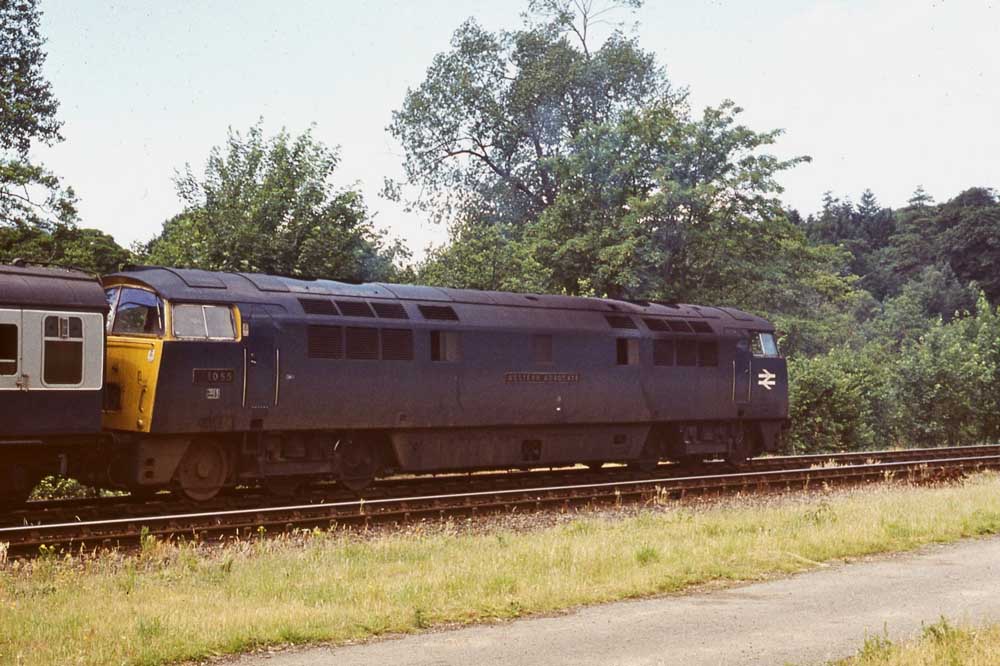
After a brief stop at Umberleigh we pass through Chapeltown and approach Barnstaple. Visible on the right is the bridge that brought in the line from the former GWR station at Victoria Road. At one time Barnstaple had three stations: Victoria Road, Barnstaple Town and Barnstaple Junction. The latter was the least convenient for local travellers and was where local geography dictated that the routes from Exeter, Torrington, Ilfracombe and Barnstaple should meet. However it did have adjacent space for the locomotive depot and goods yard.
After withdrawal of freight facilities in 1987 the track was drastically rationalised and reduced to a single track into the old up platform with a short run around loop on the approach to the station. We arrive on time at 10:35 and the driver phones through to Crediton before preparing to depart as the 10:43 to Exmouth. I have decided to wait over for an hour to photograph the departure and the arrival of the next service. The former island platform from where the down services to Torrington and Ilfracombe departed from is still in place although all the buildings have been demolished. The area east of the station where the goods yard, slaughter-house and locomotive depot were situated is now being developed as Barnstaple Retail Park. B & Q occupies the goods yard, while a large two storey Tesco is being built nearby. The main station building looks in good order and boasts new metal signs in Southern green. The area at the far end of the station where the Torrington and Ilfracombe lines diverged is now a car-park with the Western By Pass crossing at right angles. However this has been built sufficiently high enough to enable the railway to be re-instated in the future, the line to Bideford having been designated as a potential candidate for re-instatement.
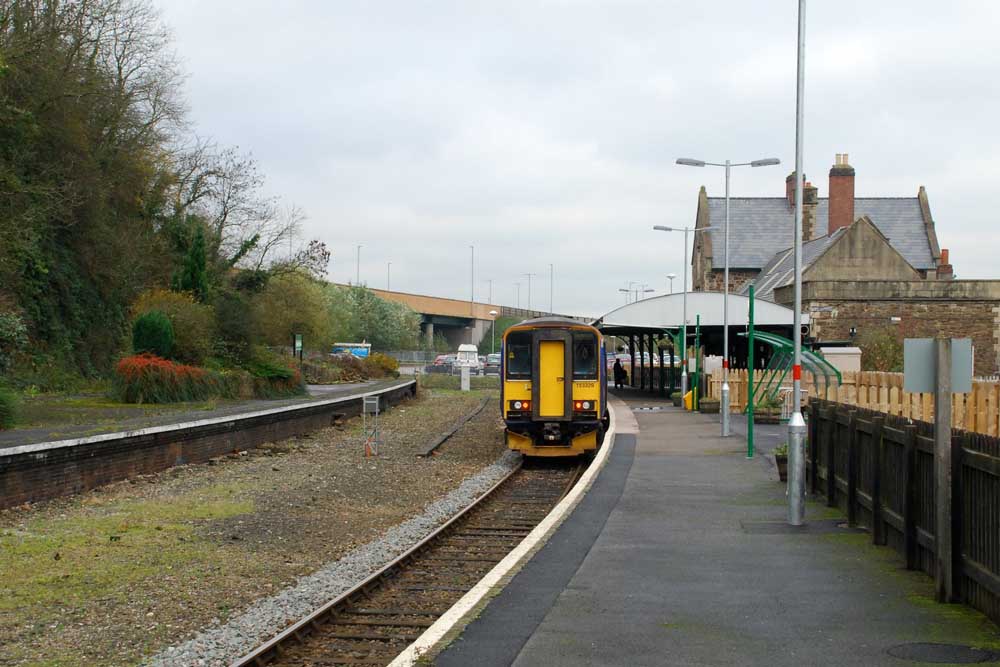
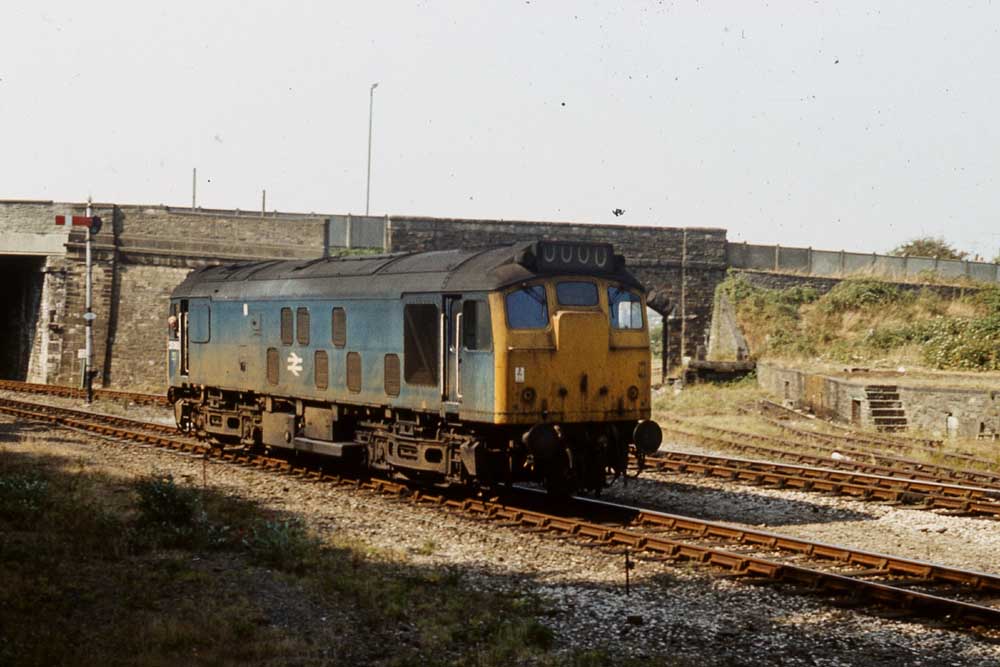
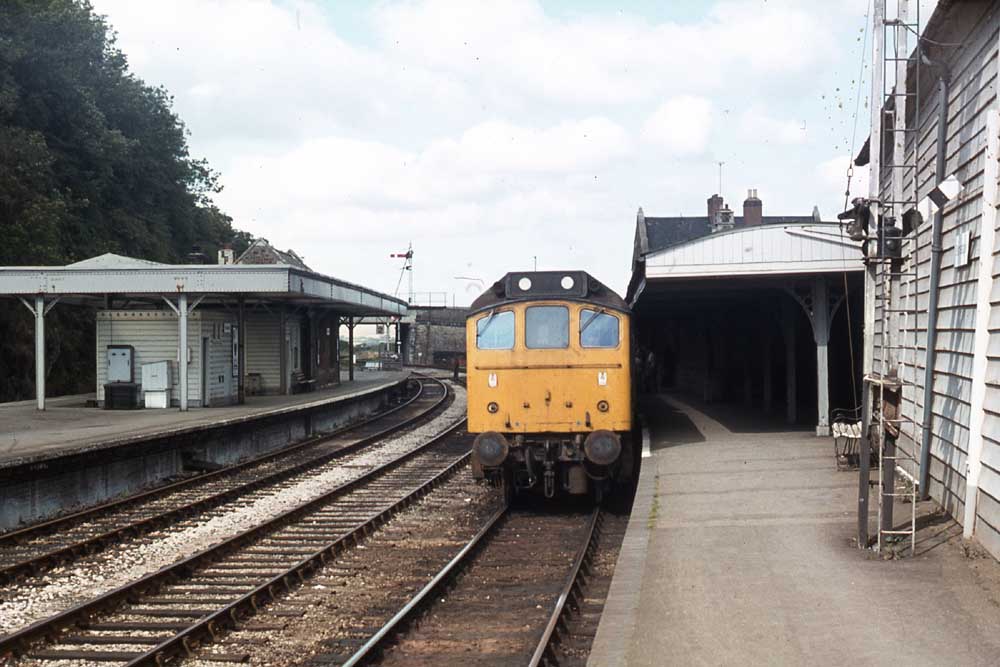
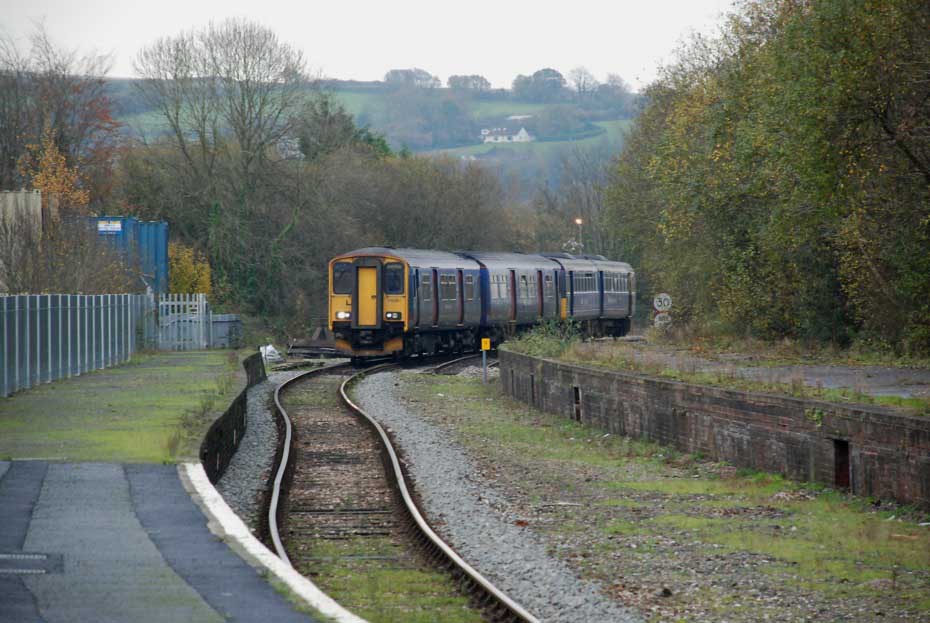
The award winning ‘Station Master’s Café’ now occupies much of the station building. It also sells a range of railway books, CDs, pictures and railway souvenirs. Outside of the station the area is devoted to bus and taxi connections, and cycle hire for the Tarka Trail from Ilfracombe to Meeth.
![]()
I only travelled from Barnstaple to Torrington once. In 1975 I had boarded a railtour at Exeter for Meldon Quarry behind 1063. When we reached Crediton on the return journey 25161 & 25224 were waiting to take over for the run to Torrington and then back to Exeter. By this time the line between Barnstaple and Halwill Junction had already been closed to passengers for ten years, and the milk traffic to Torrington was at an end.
For Christmas 2007 I had bought a fold-up bicycle. My wife was sceptical, and considered it just an expensive toy at £350. So in the spring of 2008 I thought I would give it a good run out. I studied the various cycle routes in Devon, a number being based on closed railway lines. I discounted Ilfracombe to Barnstaple after consulting my gradient profile book; best to avoid cycling the track of a line that needed bankers. I decided to cycle the 25 miles from Barnstaple to Meeth.
So on a chilly blustery spring day in early May 2008 my wife deposited me in the car-park at Barnstaple Station at about 10:45. Once the car had departed I felt a little vulnerable, with my lightweight fold-up bike with 20 inch wheels. My equipment consisted of a cycling jacket, and a rucksack containing my mobile phone, a bottle of water and a spare inner-tube. I had told my wife to collect me from Meeth at 15:00.
After working my way out of the station and under the new Western By-Pass I set off towards Bideford on the old track bed. Fairly soon I was hit by the blustery westerly wind, especially on the exposed areas along the Torridge Estuary where there is no protection from the trees. Eventually I settled the bike in third gear, rather than fifth and plodded towards Fremington Quay. A number of cyclists come in the opposite direction, each giving me a cheery wave, the winding blowing them effortlessly towards Barnstaple. Perhaps they planned to catch the bus back to Bideford. With hindsight I should have done this the other way around, starting at Meeth.
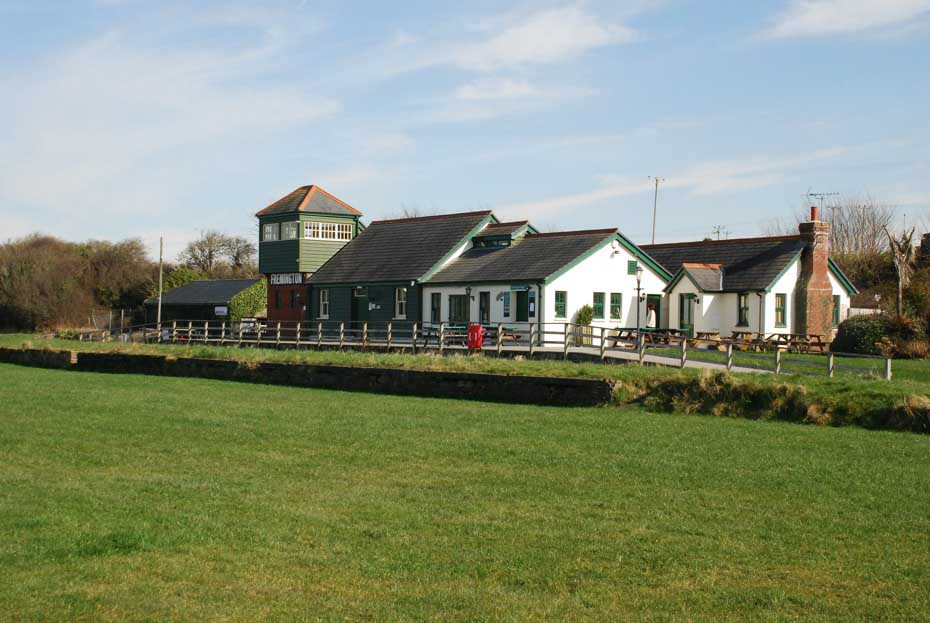
Eventually I reach Fremington Quay and start to get some protection from the wind. When the Class 25s first arrived in the autumn of 1970 the quay with its steam cranes had just closed bringing to an end the delivery of coal and aggregates by small coasters that would come in on the tide. However Class 25s did visit the quay to use the weighbridge. On the other side of the estuary is Appledore and I start to get some idea of the extent of residential development in recent years, as the hillsides are covered in new houses.
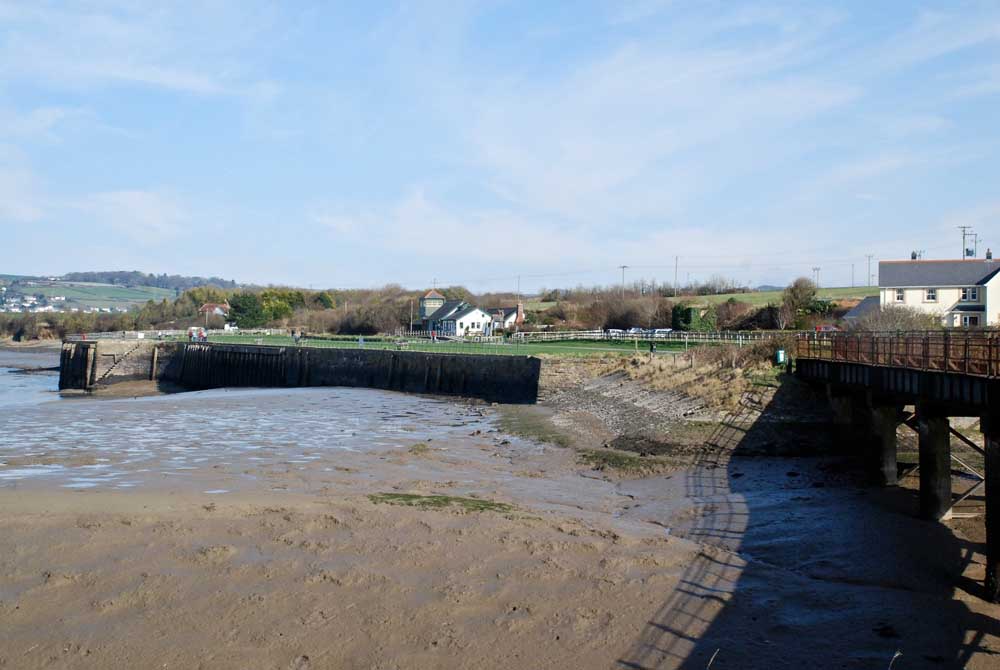
As I cycle on from Fremington alongside the Torridge Estuary the wind drops and my speed picks up. The line was built by the L&SWR to main lines standards, and apart from an incline either side of Bideford Station to assist deceleration and acceleration the ruling gradient is no more than 1 in 400, making it an excellent cycling route.

The next location is Instow. Here the signalbox has been preserved and is now a Grade 2 listed building. With the two home signals and a short section of track it is maintained by the Bideford Railway Heritage Centre, and open to the public on Sundays and Bank Holidays. Finally I get the bike into fifth gear and speed towards Bideford.

Here the cycle path runs beside the station that is preserved by the Bideford Railway Heritage Centre with a café operating from a Mk1 coach. They have a few items of rolling stock and have occasionally operated over a couple of hundred yards of track. With so many established preserved lines in the West Country it is probably difficult to get the critical mass of support to expand further, and the site has suffered from vandalism in recent years.
Having now completed nine miles I speed down the short incline from Bideford Station and head towards Torrington. The surrounding countryside now changes, from open estuary to a winding river valley with an abundance of line-side trees. Last season’s leaves make the surface slippery, a candidate for some railhead cleaning. It is probably along this section that the story originated that delighted Dr Beeching and WR management. In the late 1950s an M7 hauling a two coach Torrington – Barnstaple train collided on a crossing with a bus for Barnstaple. Fortunately none of the five people involved were injured. These were the bus driver, conductor, train driver, fireman and guard. Neither train or bus had any passengers on board.
Along this section track it is very peaceful and tranquil and there are few other people. Near the attractive village of Weare Gifford the line curves around, dropping a gear I pedal steadily up the slight rising gradient until in the trees ahead I see a Mk1 coach, and arrive at Torrington Station, 14 miles from Barnstaple.

The former station has now been re-opened as the Puffing Billy Pub and is full of railway memorabilia. It is the main base of the Tarka Valley Preservation Group. Outside of the station against the former platform some track has been re-laid for the Mk1 coach, a goods brake van and a clay hood. The site is also home to ‘Progress’ a Fowler 0-4-0 diesel shunter, formerly used to shunt the private clay sidings at Marland.
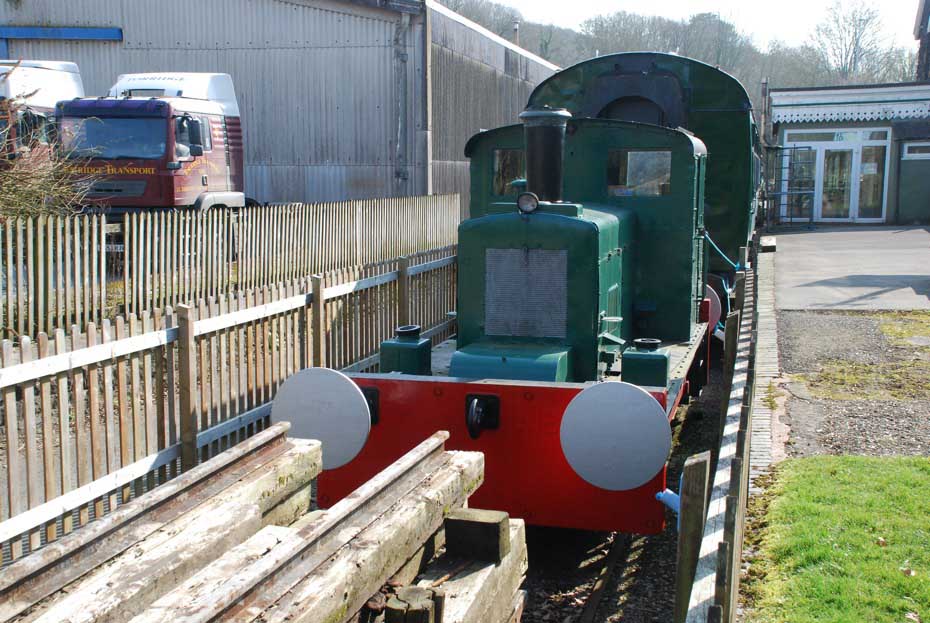
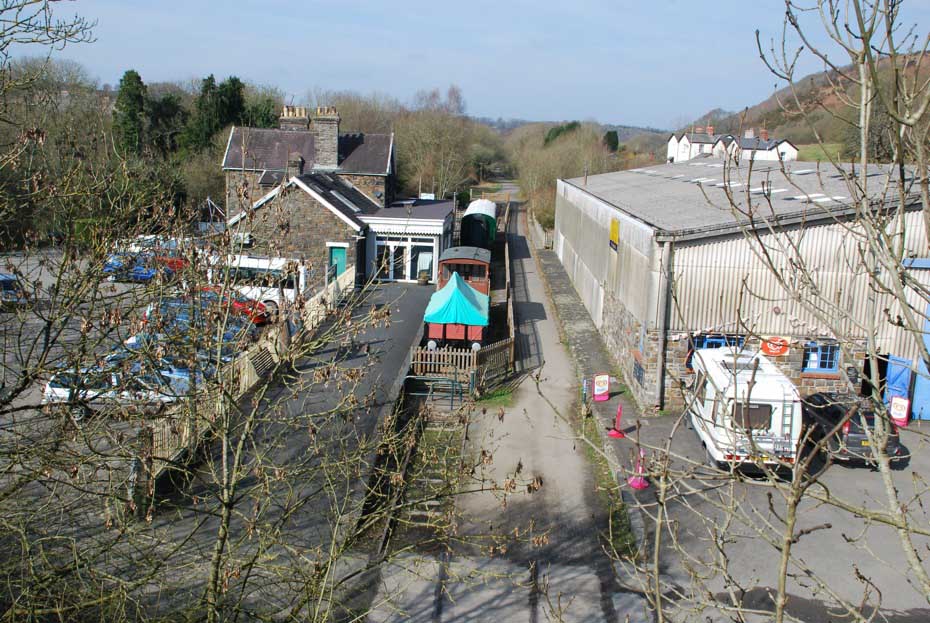
After a freshly made baguette and a couple of pints of lager (cycling is thirsty work) I’m ready for the final 11 miles to Meeth. Until now I’ve been riding on trackbed engineered by the LSWR to main line standards. From Torrington the line was built in 1925 as the North Devon & Cornwall Junction Light Railway linking up with the Southern line to Padstow at Halwill Junction. Funding for the line came from the Government to provide local employment during the depression, the section to Meeth being built on the former three foot tramway used to carry clay.
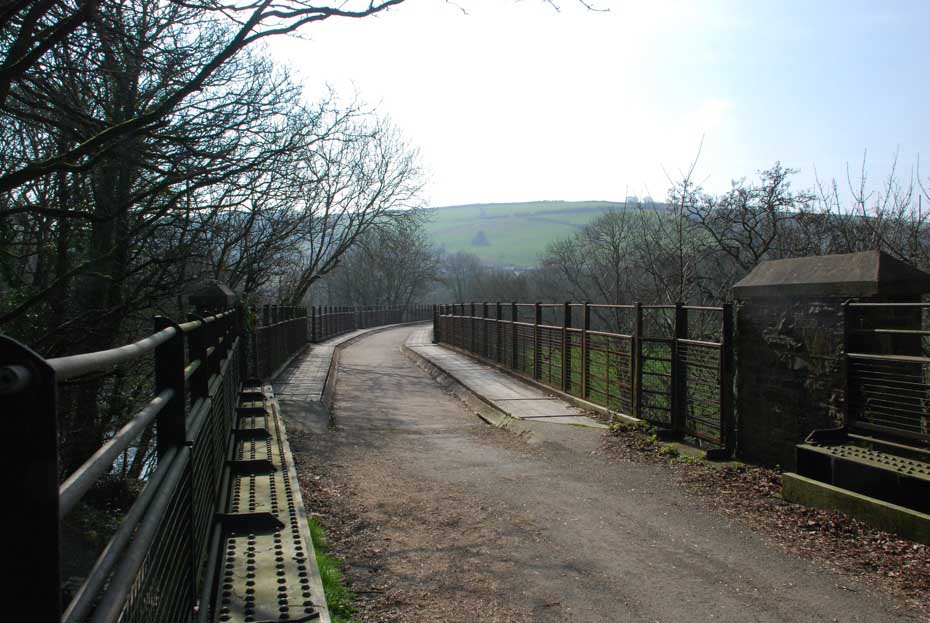
After leaving Torrington I can tell the difference in the engineering of the line. Descending down a steep gradient I have to apply the brakes for the sharp curve on the sweeping viaduct over the River Torridge. The track crosses the valley and climbs steadily through some woods. The track is little used at this time of year with plenty of wet fallen leaves. There is a distinct feel of moving into a much more isolated rural area as I cycle through this sparsely populated area of West Devon.

After climbing for what seems an age I cross a road and arrive at the little pre cast concrete platform of Watergate Halt, just long enough for the one coach that sufficed on the trains to Halwill Junction. Checking my leaflet I have travelled only two miles from Torrington, so still nine miles to go. I wearily plod on and after another quarter of an hour arrive at Yarde Halt, another one coach concrete platform. The clay workings started in this area and adjacent to this little halt is a row of houses, probably for people employed in the clay industry at nearby Peters Marland. Here I see the only people on the journey from Torrington to Meeth.
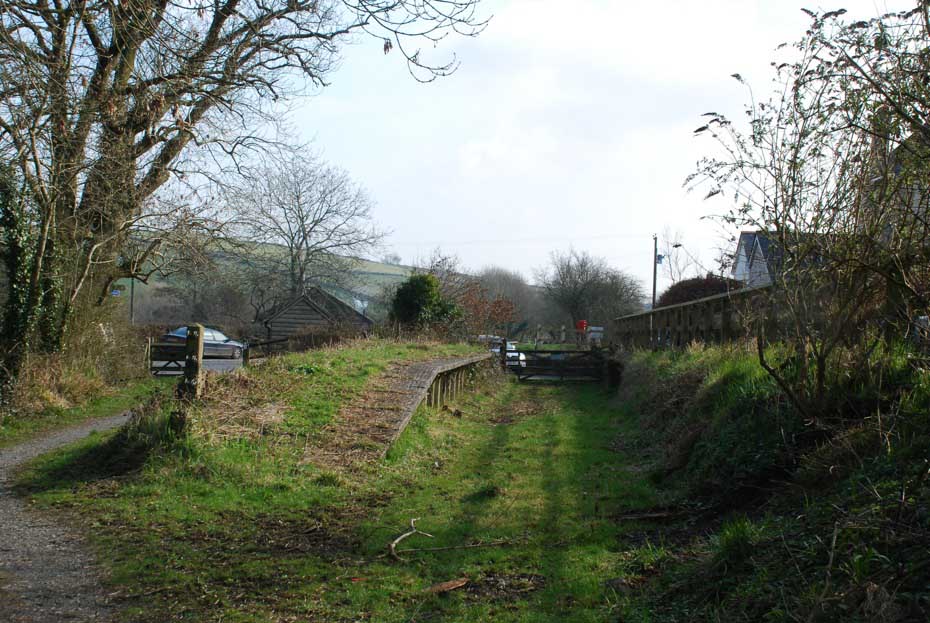
From Yarde the track starts to descend but the track is muddy making progress slow, the small twenty inch wheels are not too stable (perhaps I should have brought an off road bike with more rugged tread on the tyres. However the gradient is downhill so it’s just a case of staying on. Soon I pass the little halt at Dunsbeare in the heart of clay mining country.
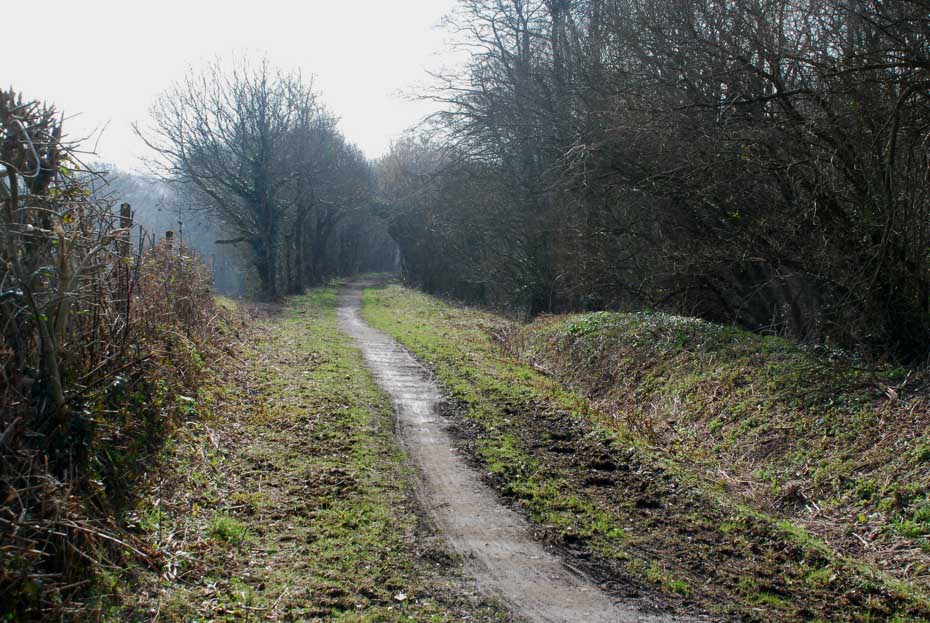
Two miles further on and I’m at Petrockstowe, a little village in the rolling countryside. Shall I call it a day and phone my wife? Of course not. With the end in sight I set off on the final three miles to Meeth. After about a mile the track takes a sharp turn to the right. Here the original line passes through an area with extensive clay workings on either side. These are now flooded and considered too dangerous so the cycle path takes a diversion across safer ground. After cycling through a country park the track rejoins the former railway line and in front of me is the little concrete one coach halt at Meeth, 26 miles from Barnstaple.

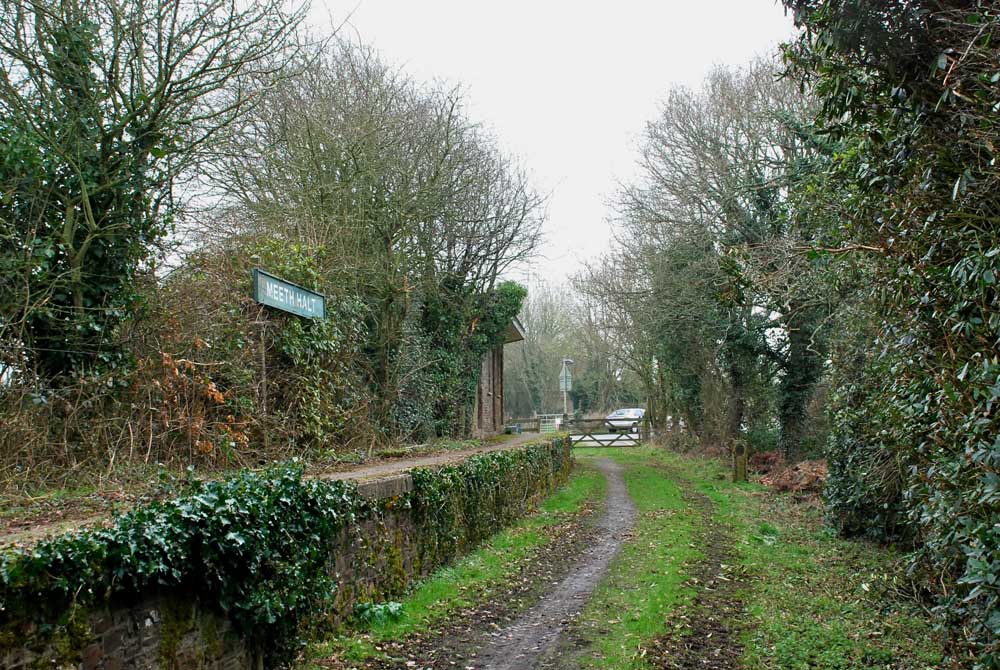
I phone my wife who is waiting in the pub car-park in Meeth Village. Inevitably it’s a little way from the station, and off I go again. Finally I find the car, but have to climb a hill too steep for my first gear so I end up pushing the bike; my legs are absolutely killing me. Arriving at the car I first collapse the bike into the boot and then myself into the drivers seat. My wife asks me if I’m tired and want her to drive? Looking cheerful I reply ‘Of course not, I’m fine!’
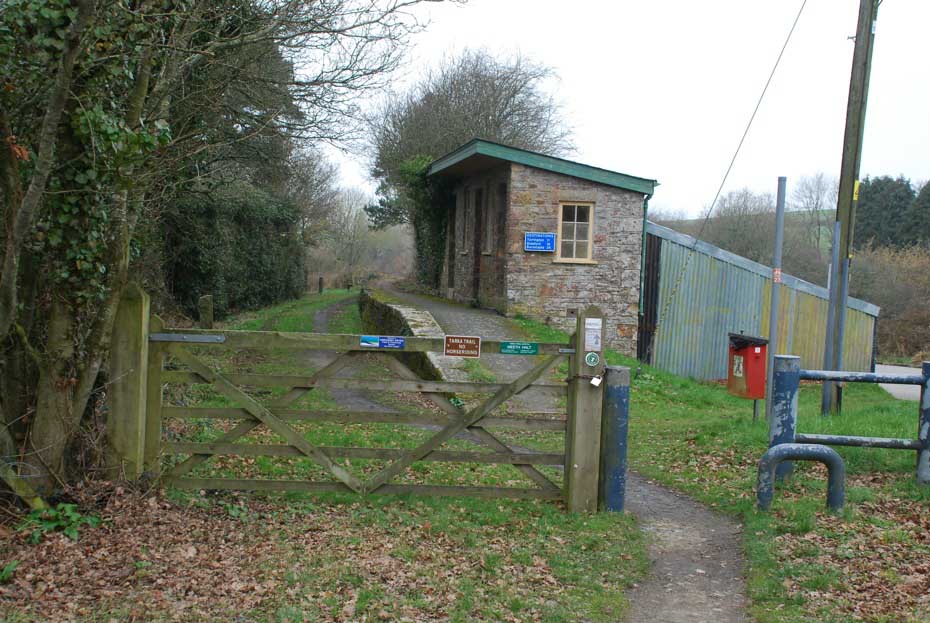
For more photos of Torrington to Meeth and some of the other North Devon lines visit:
http://northdevondiesels.webs.com/
Page added December 25th 2010.
Page last updated November 9th 2011.
![]()